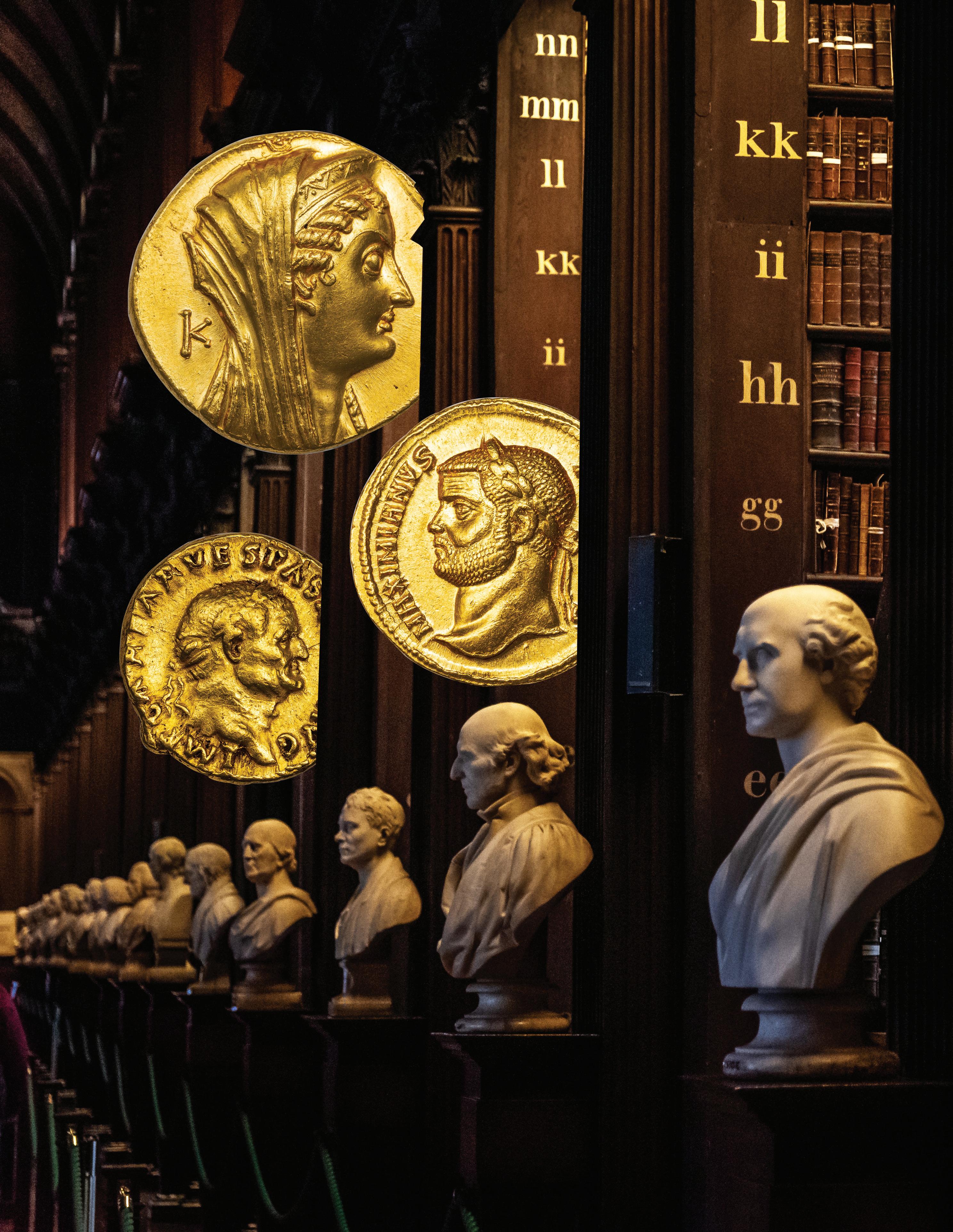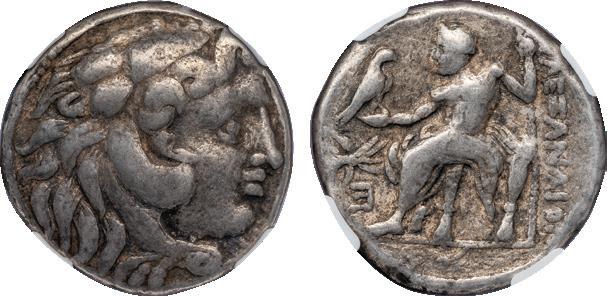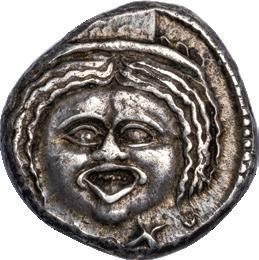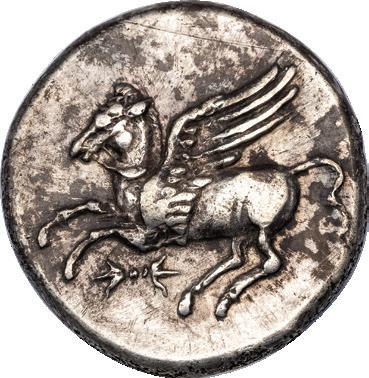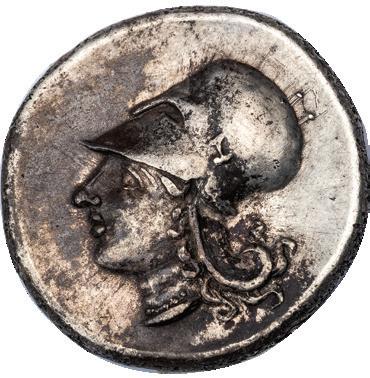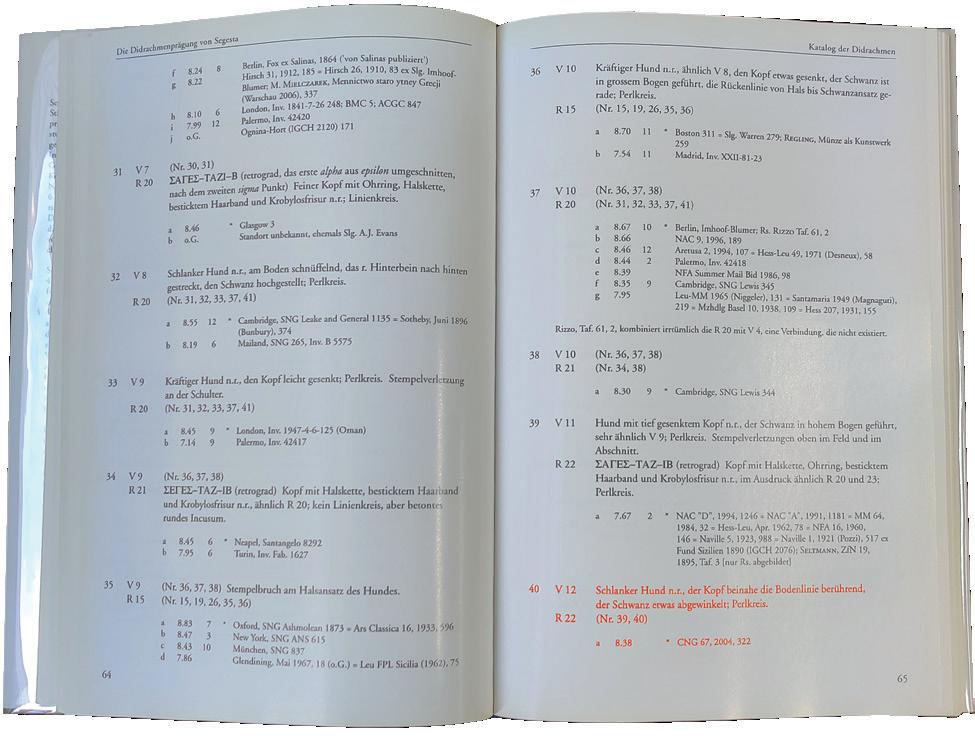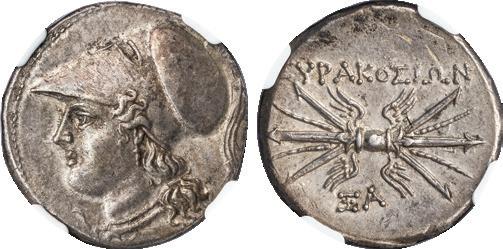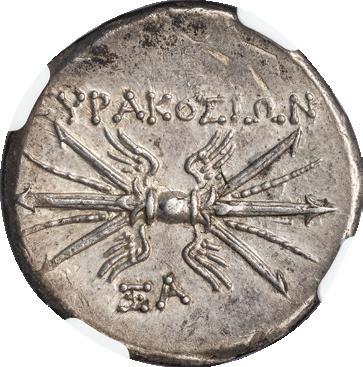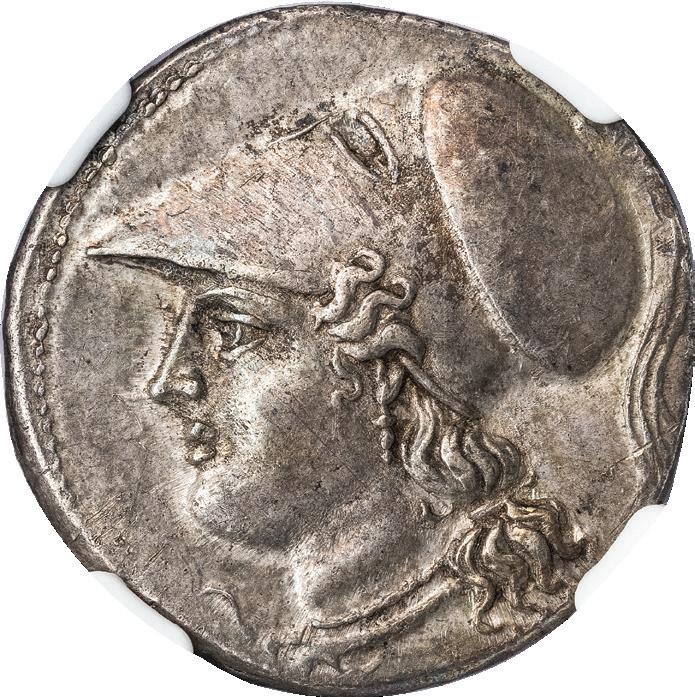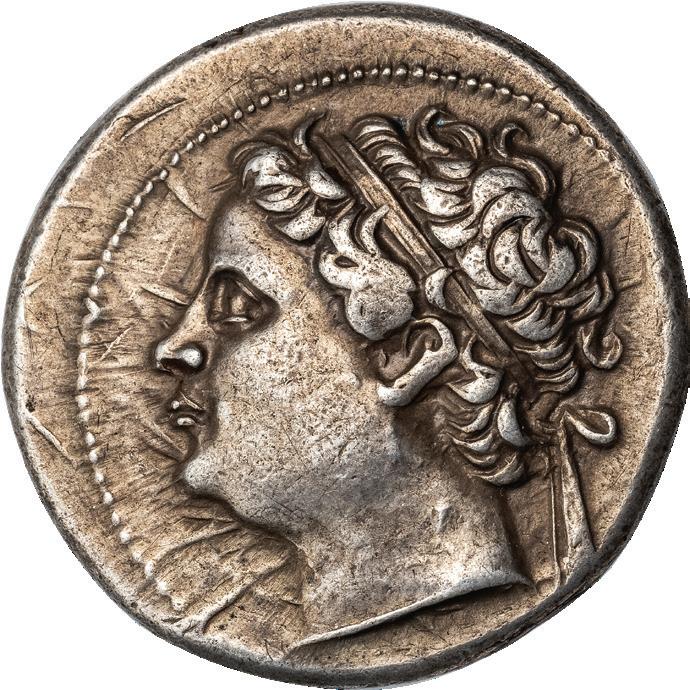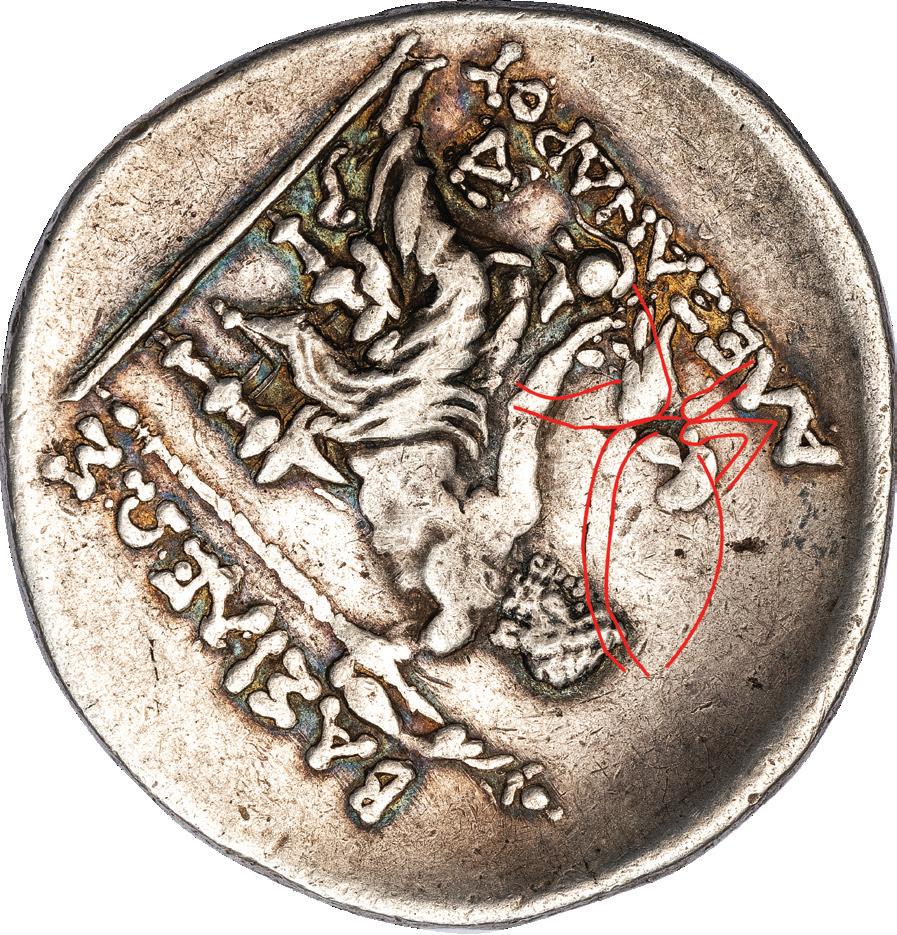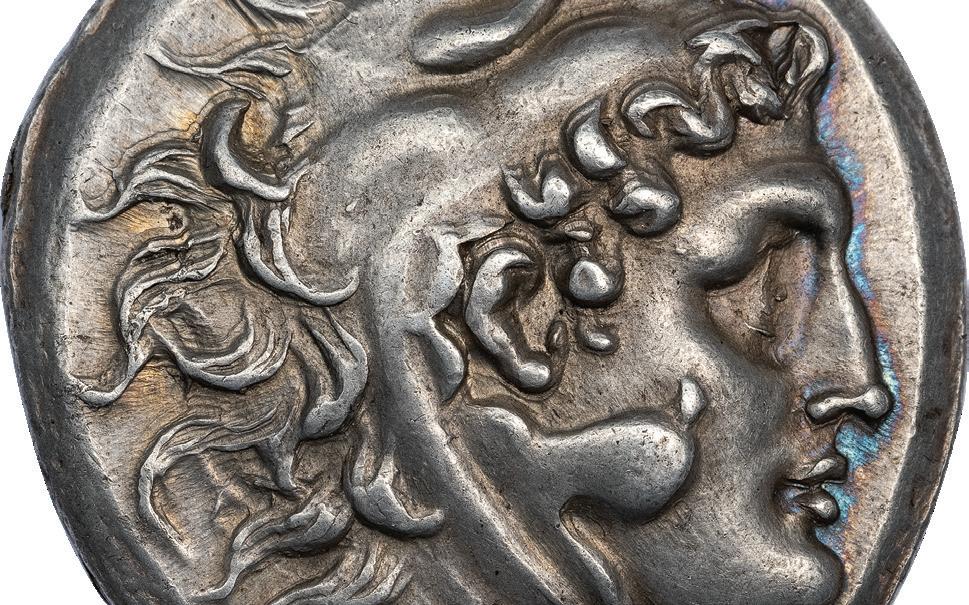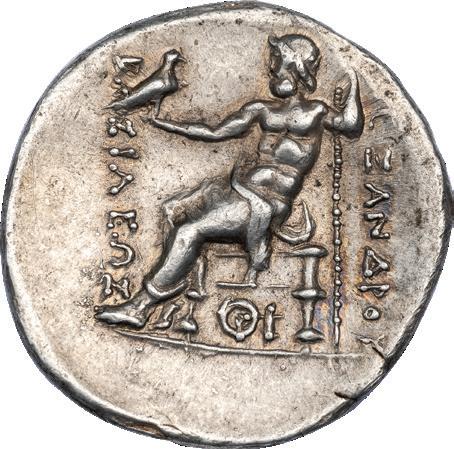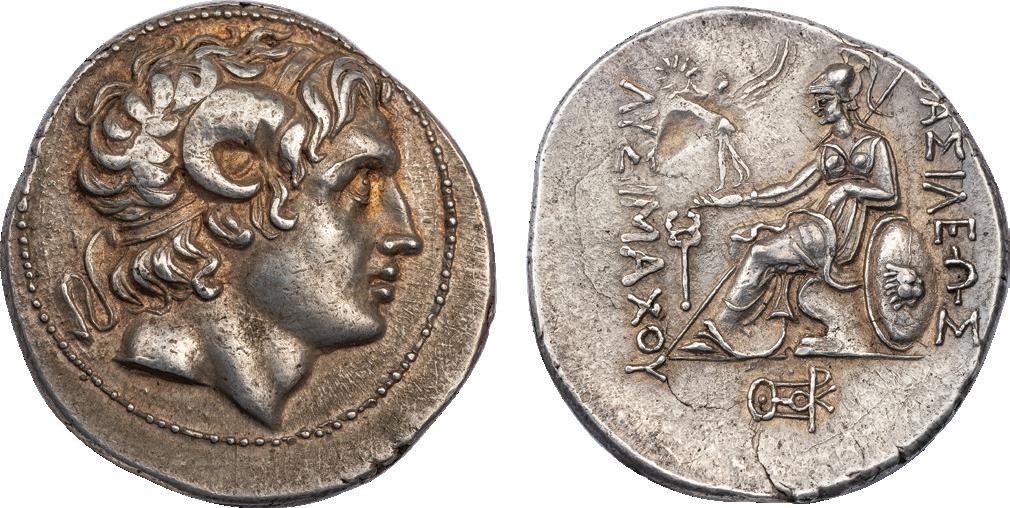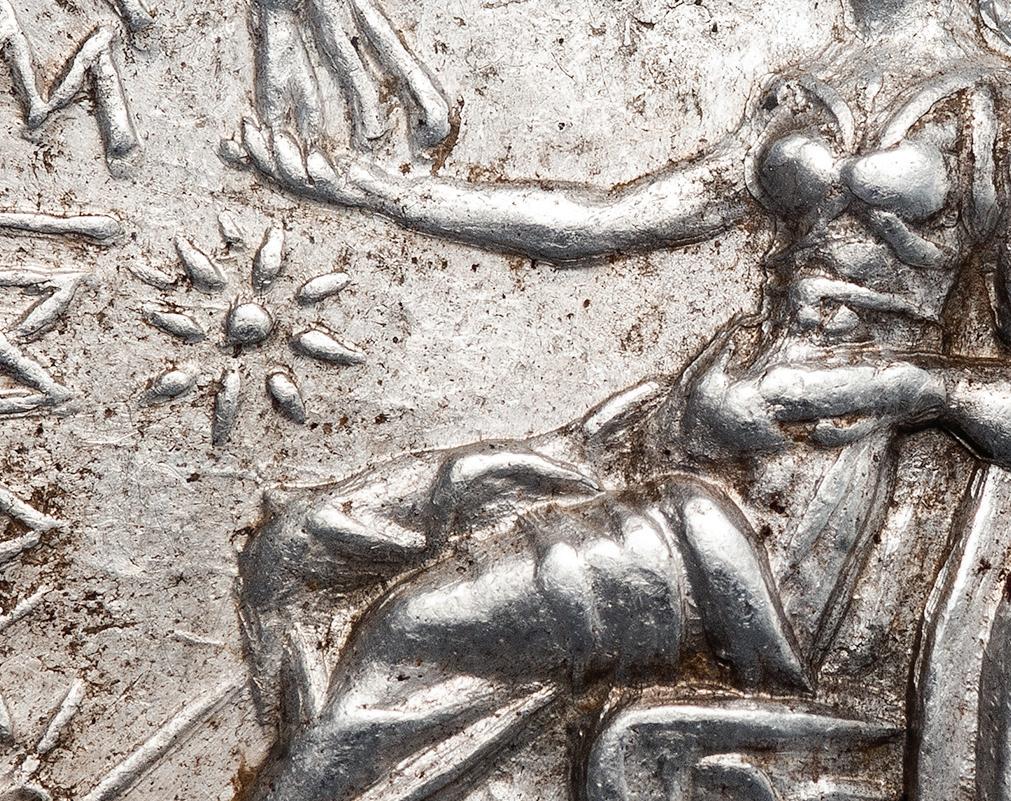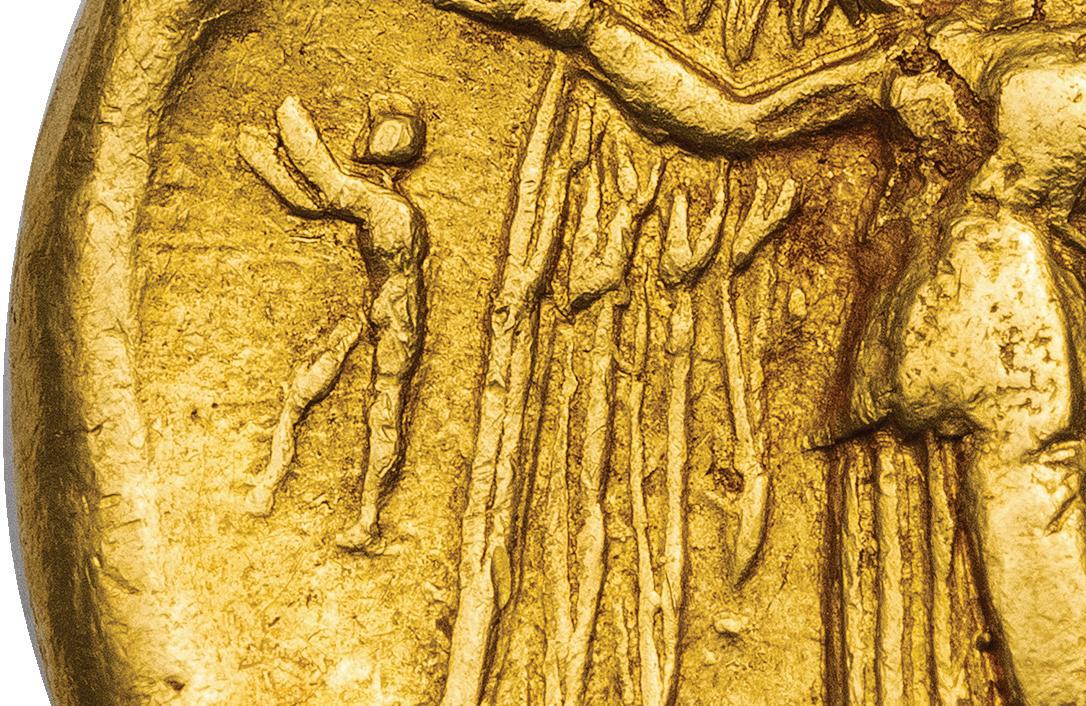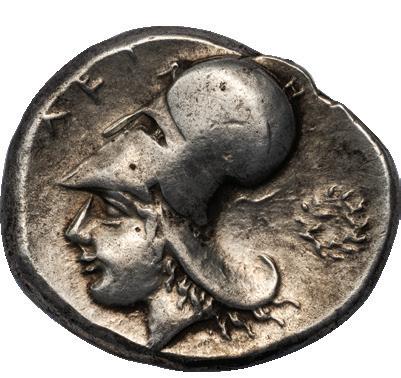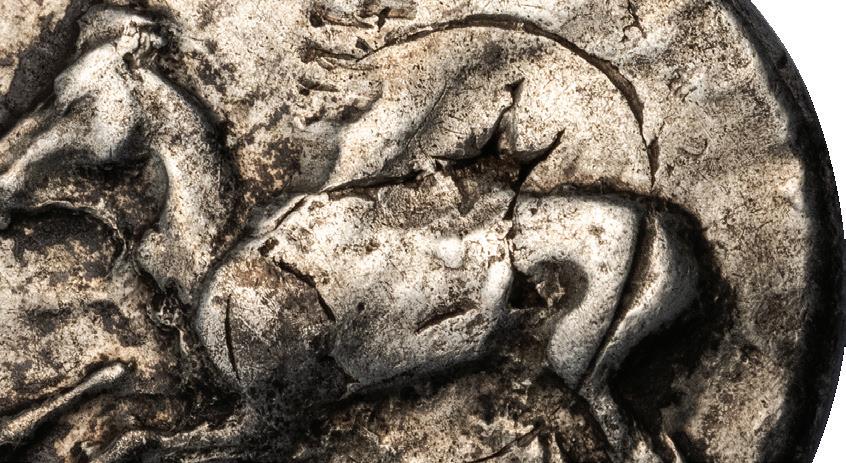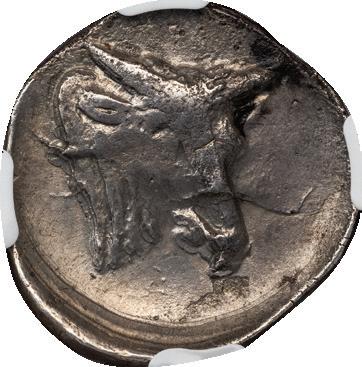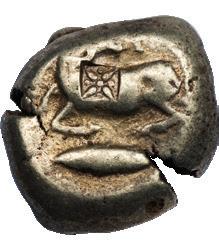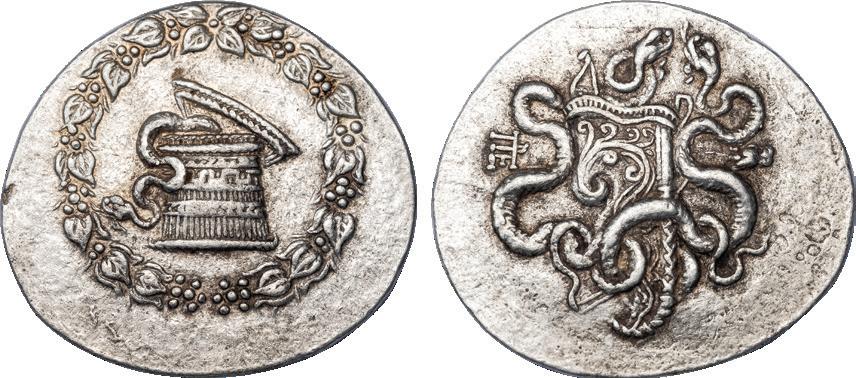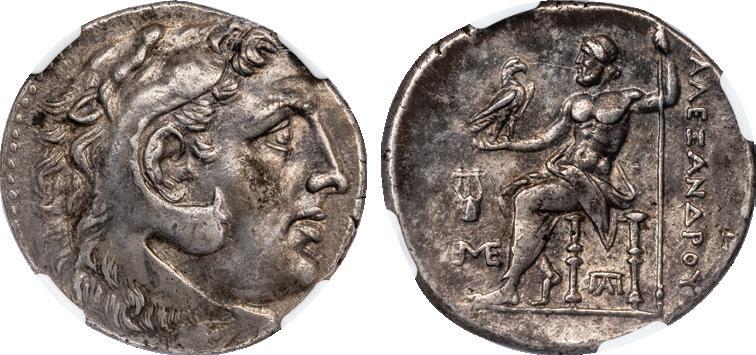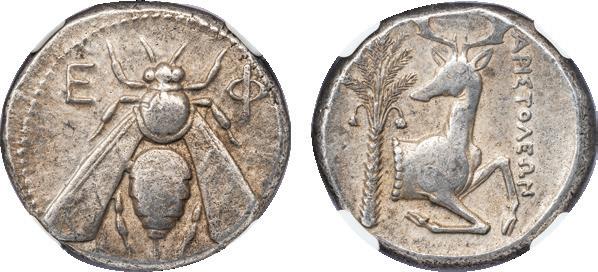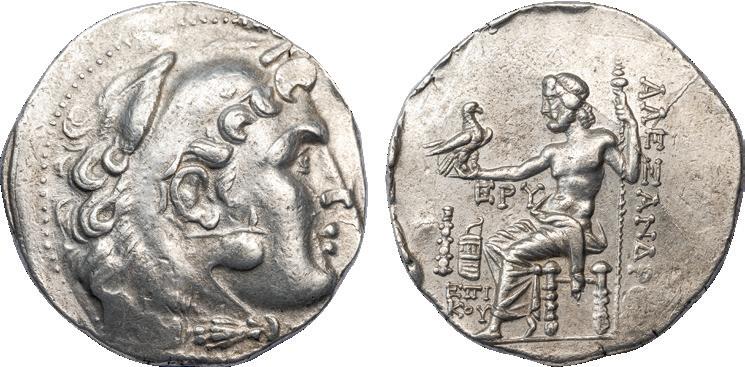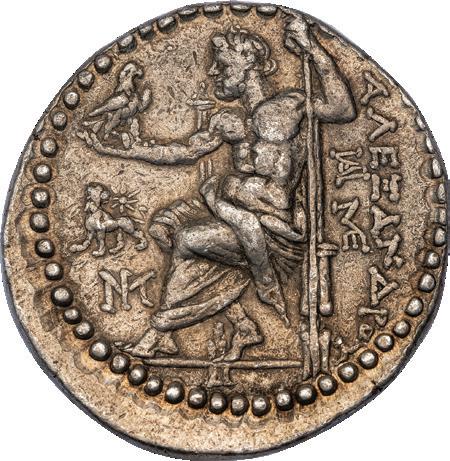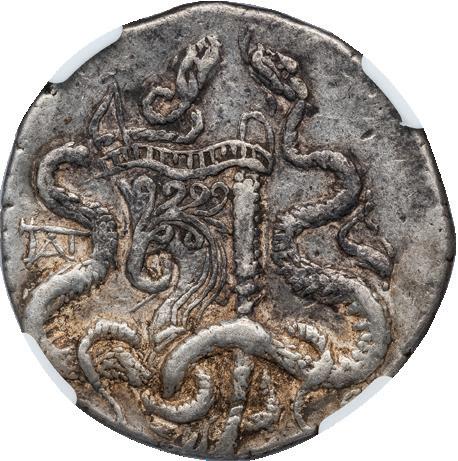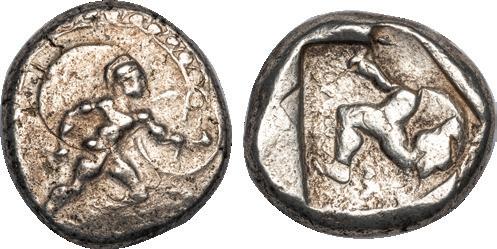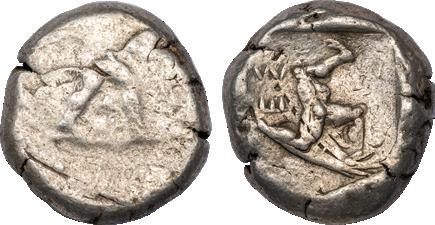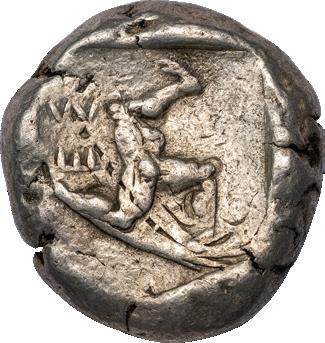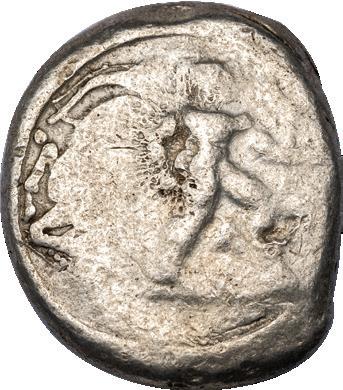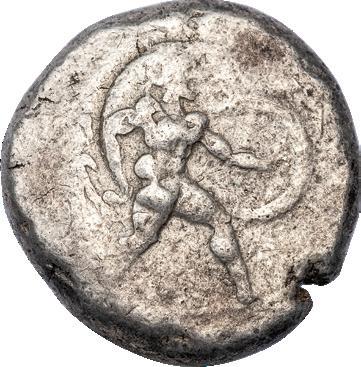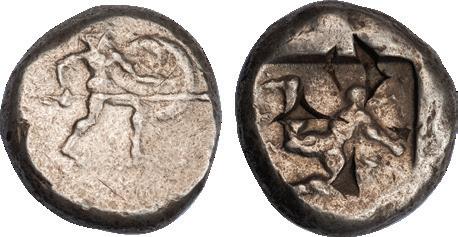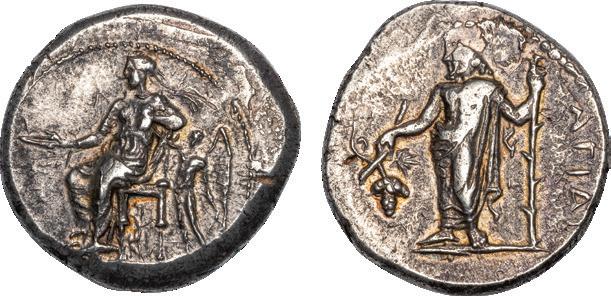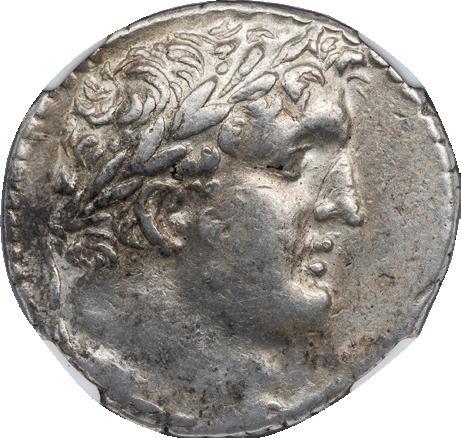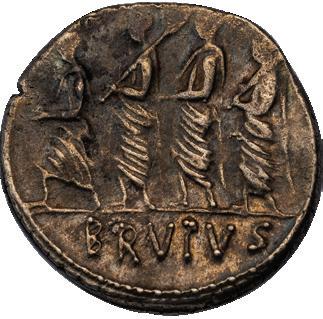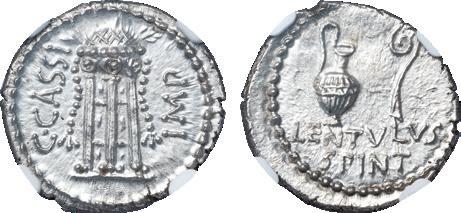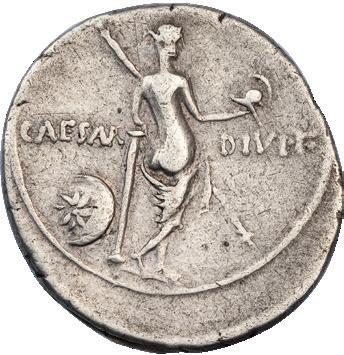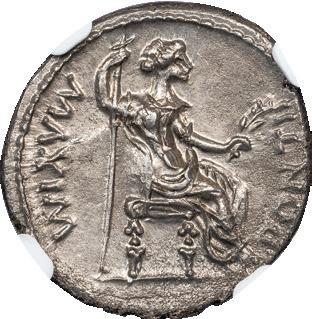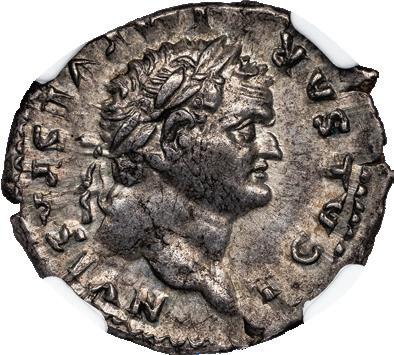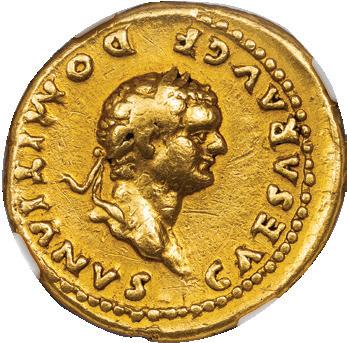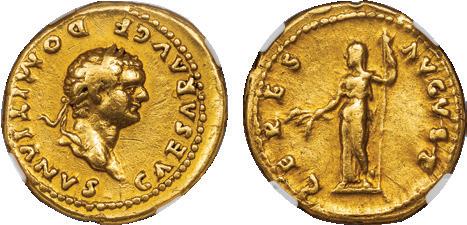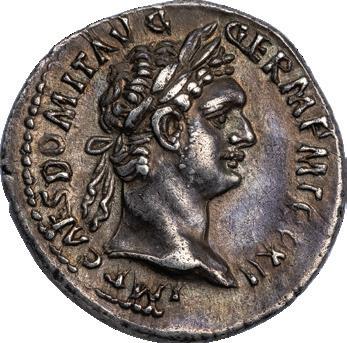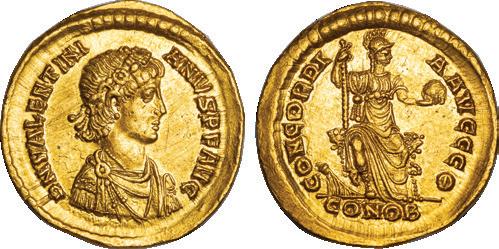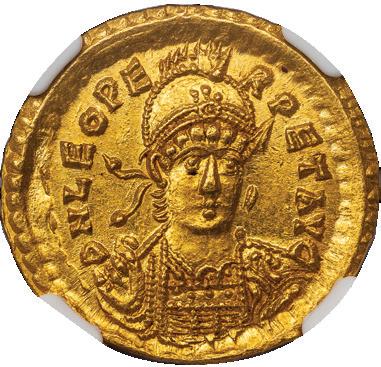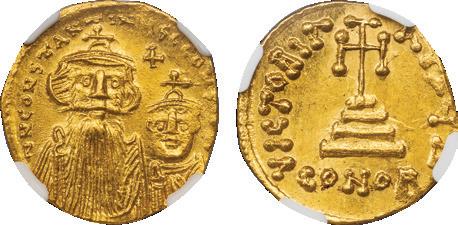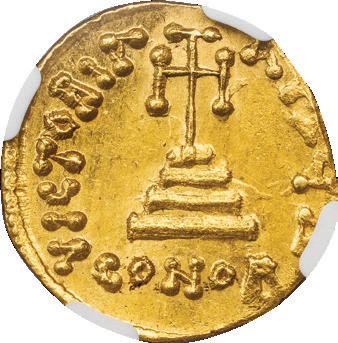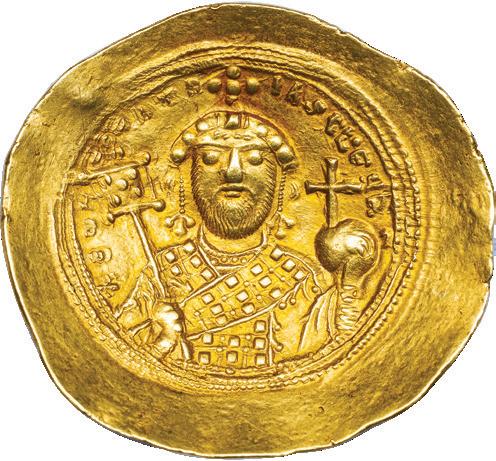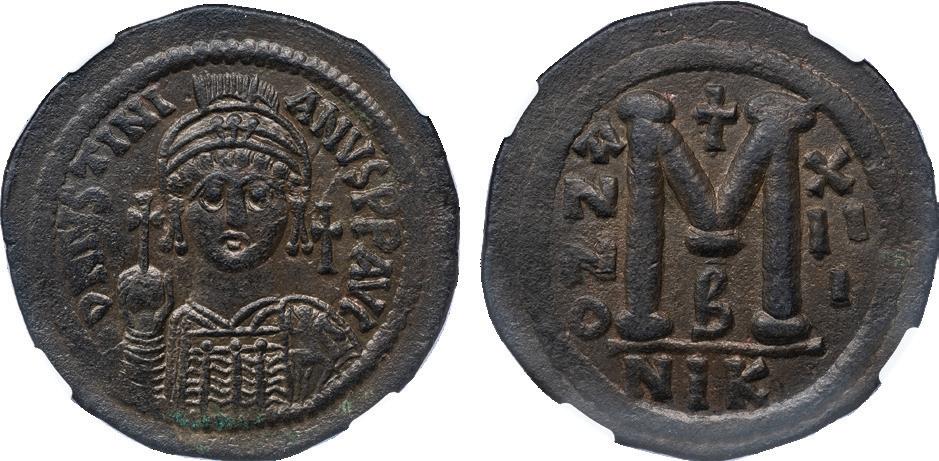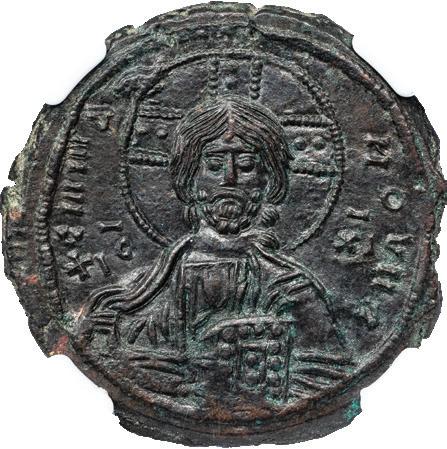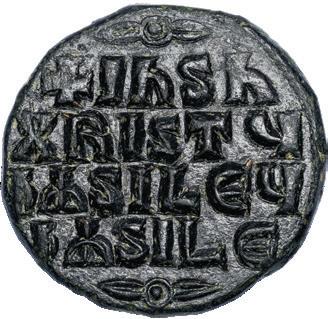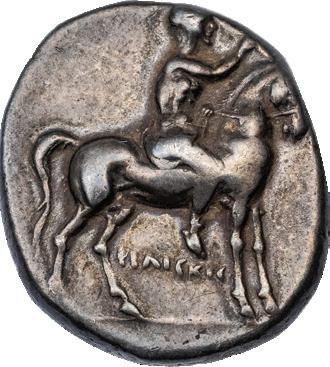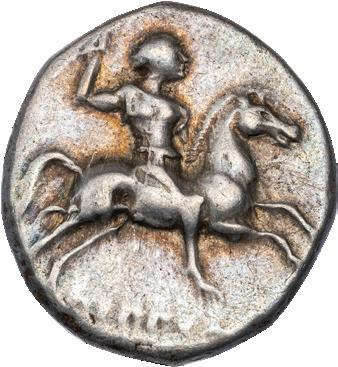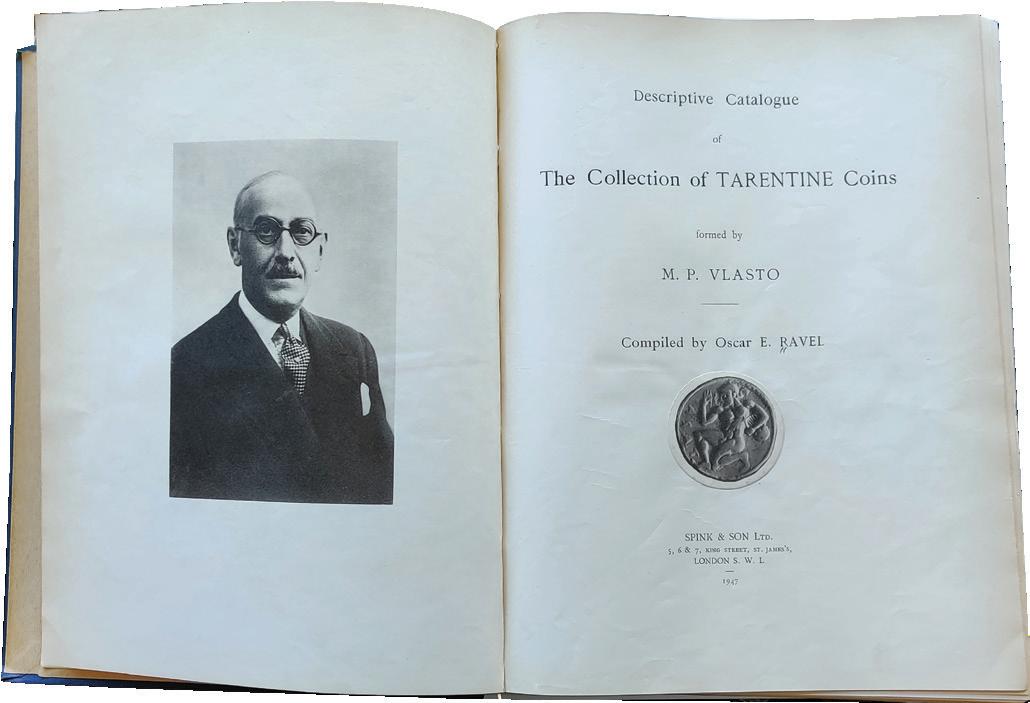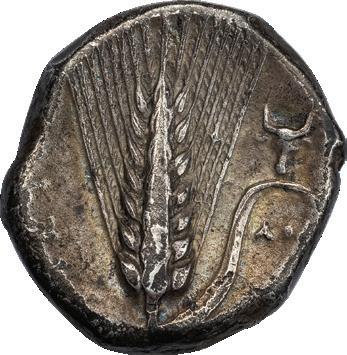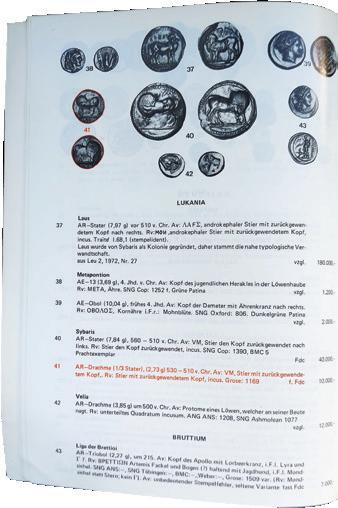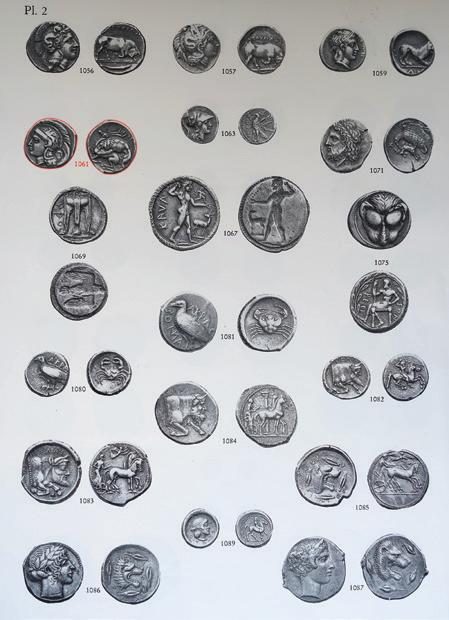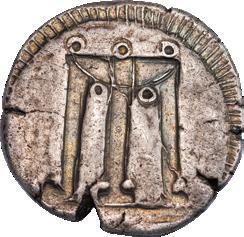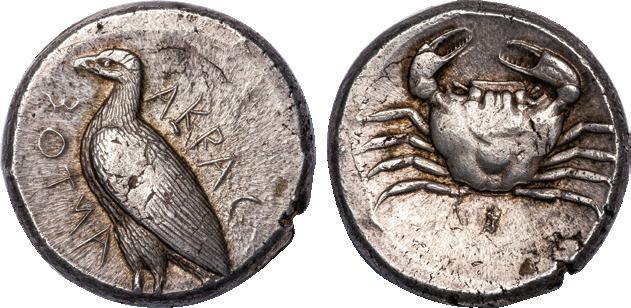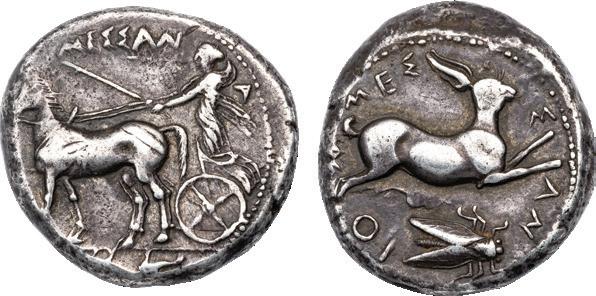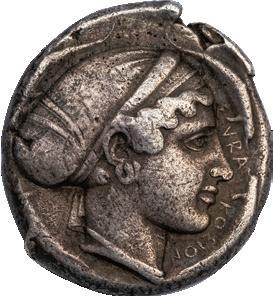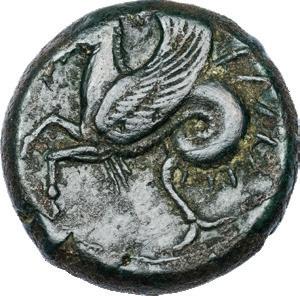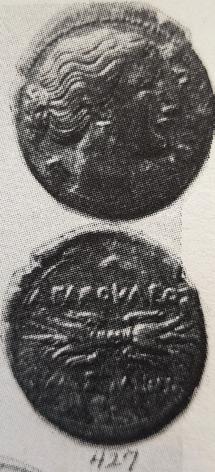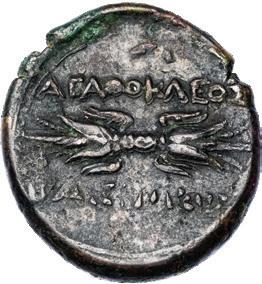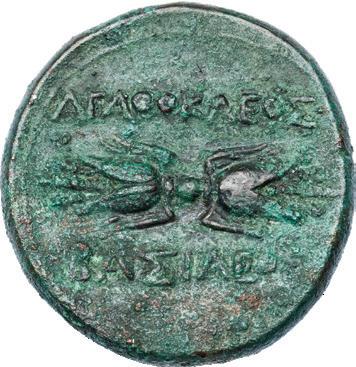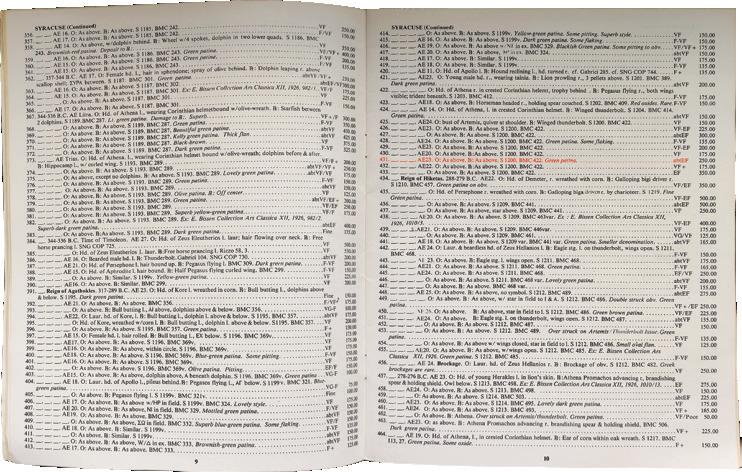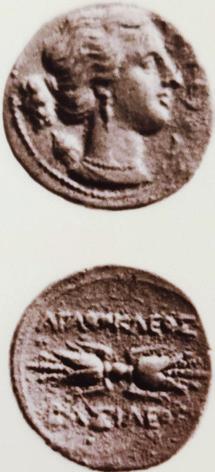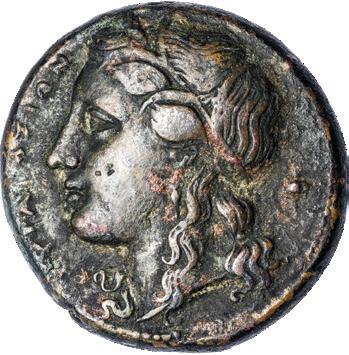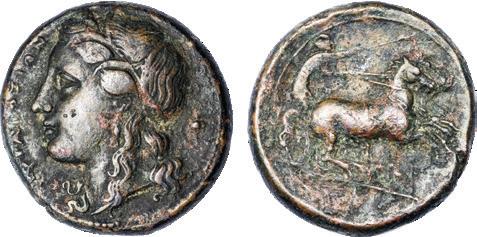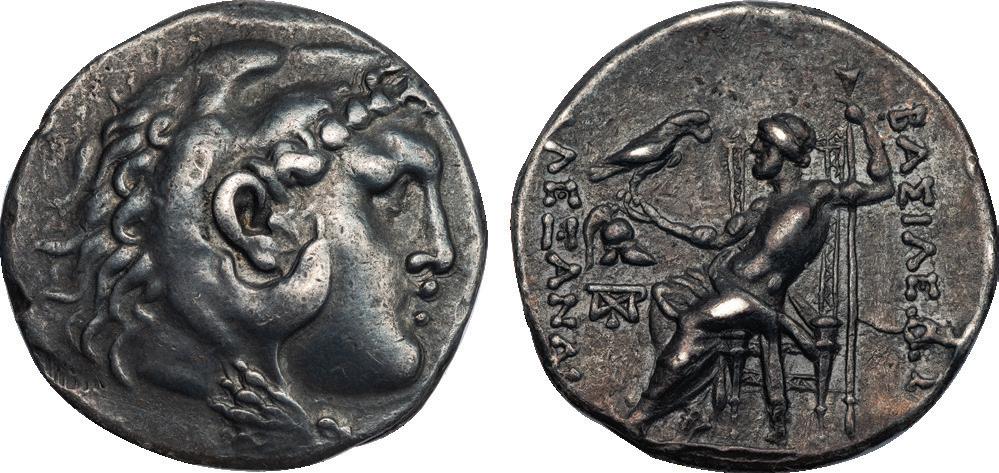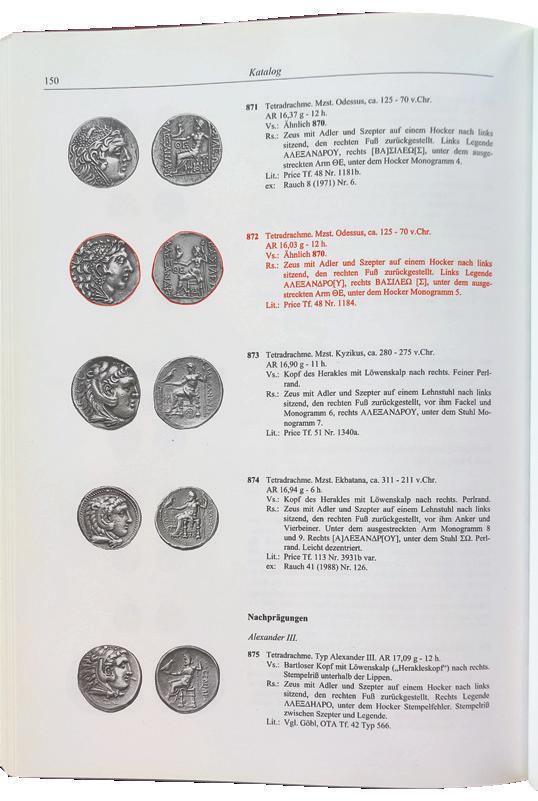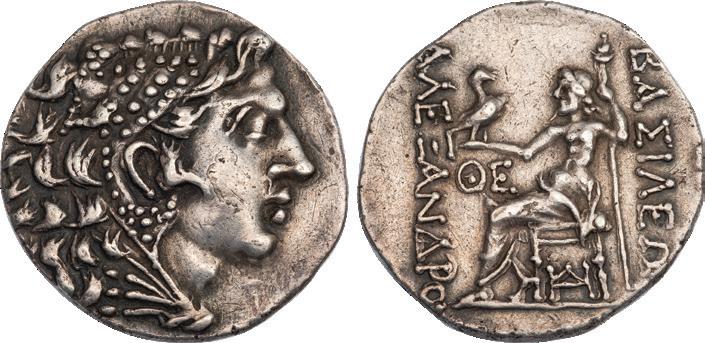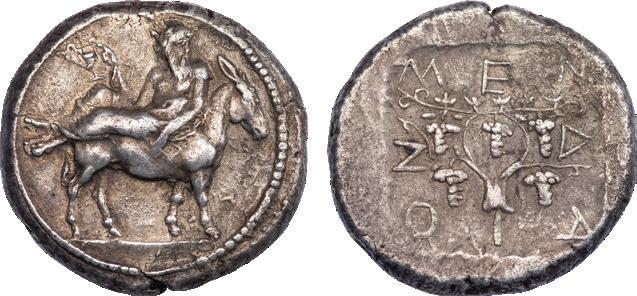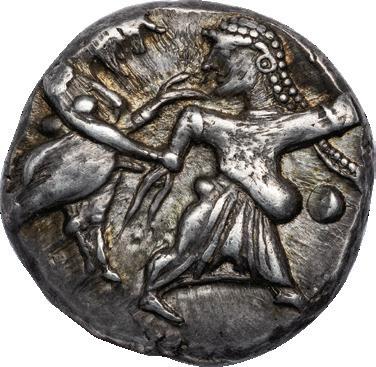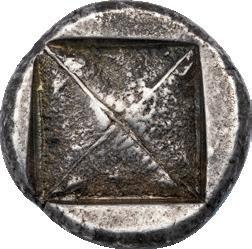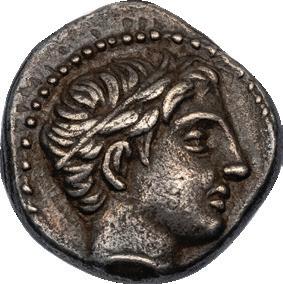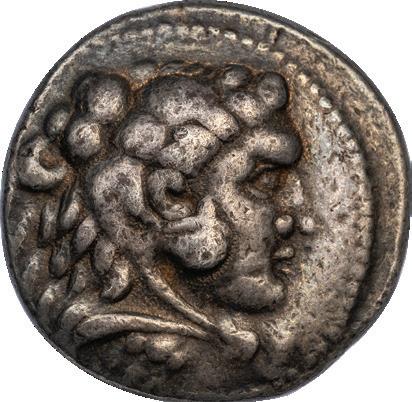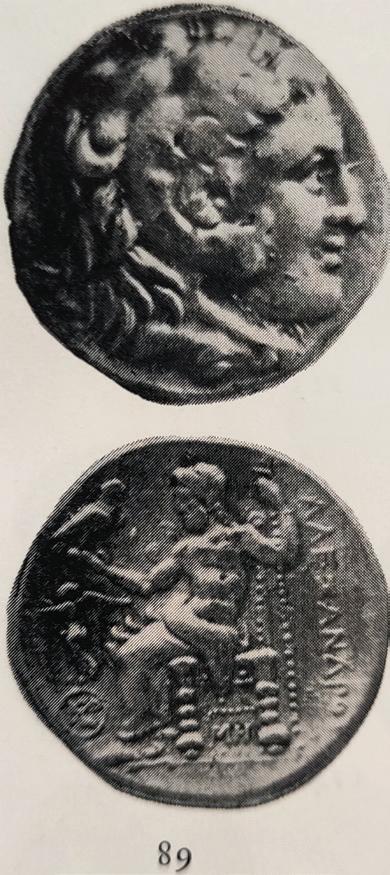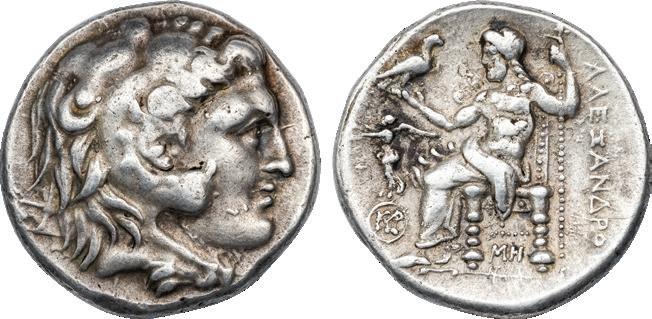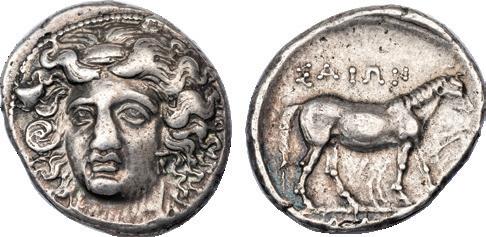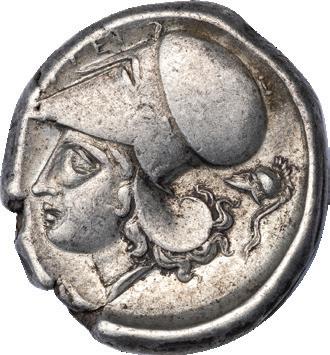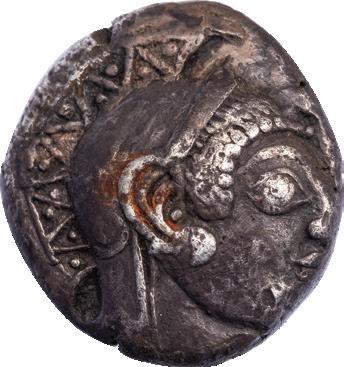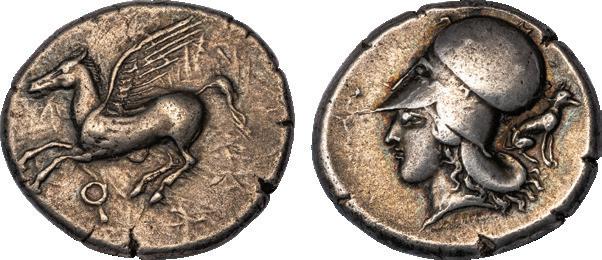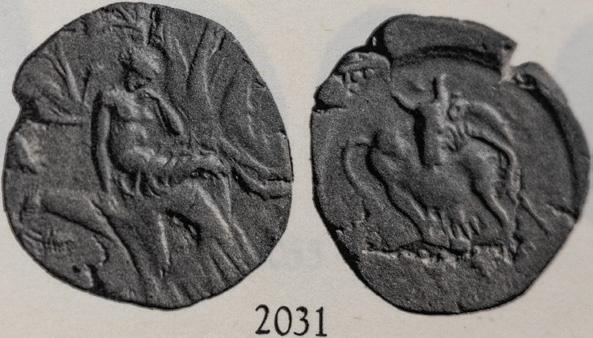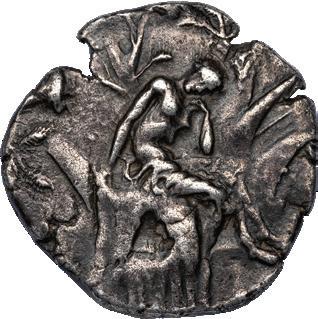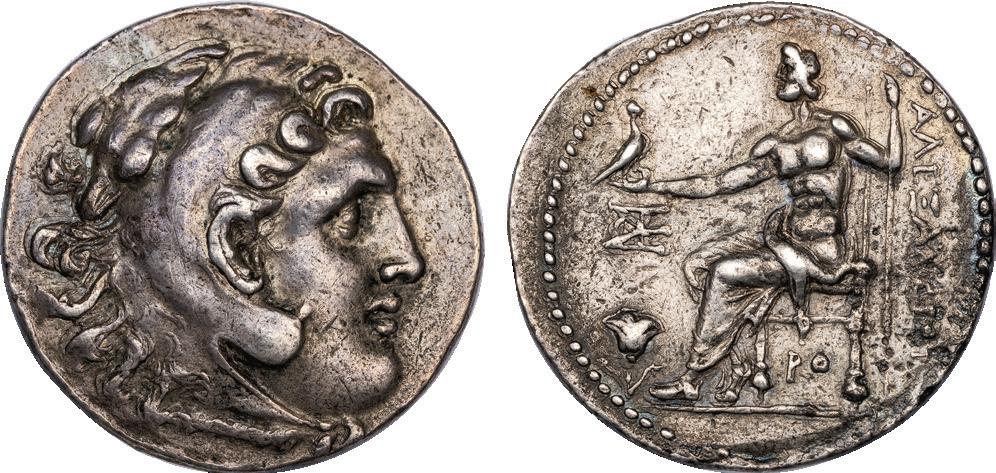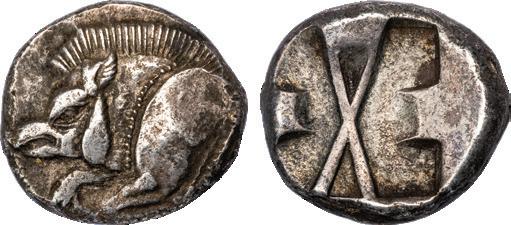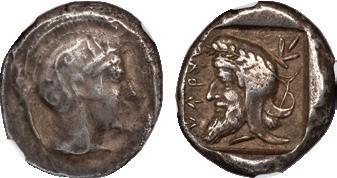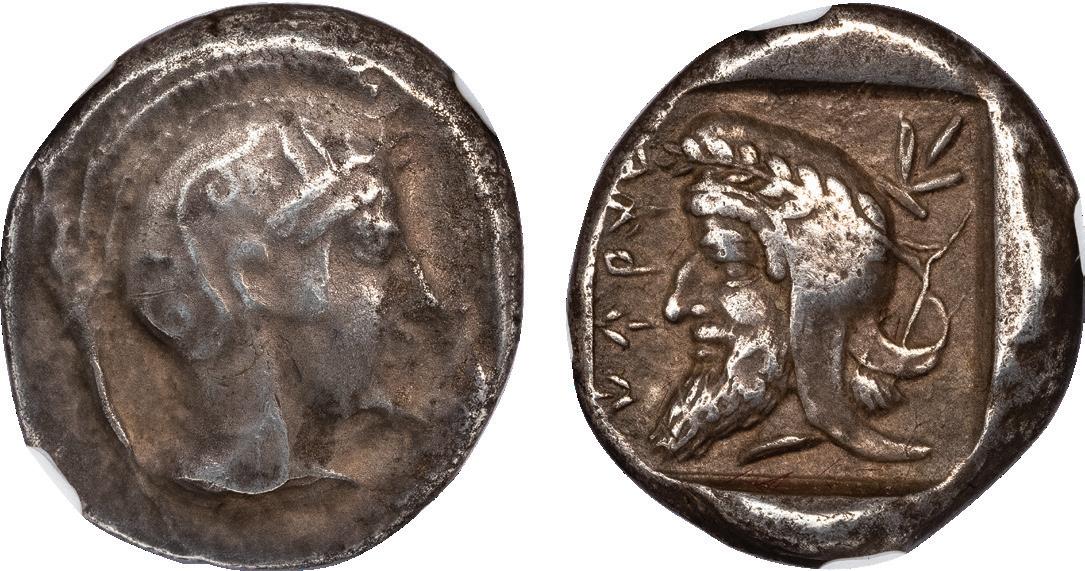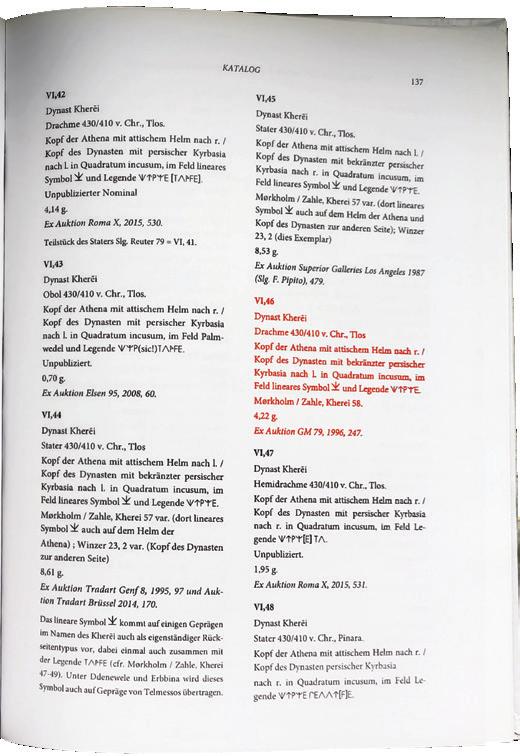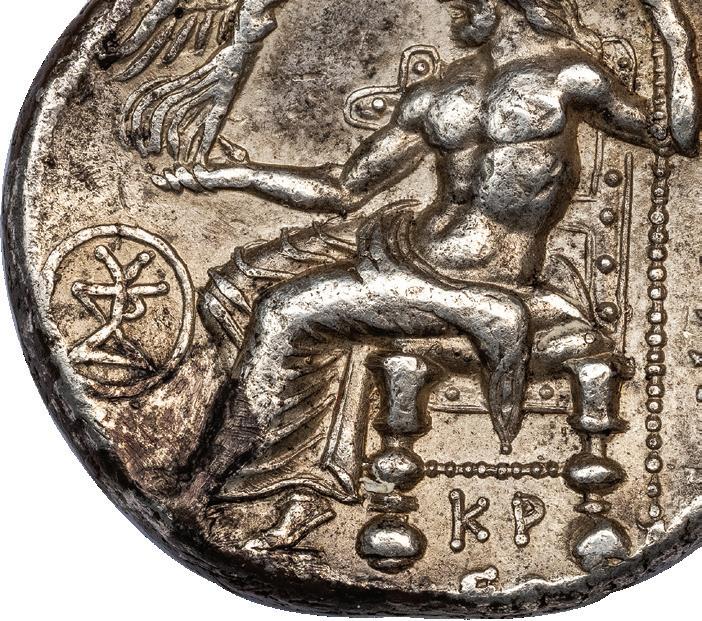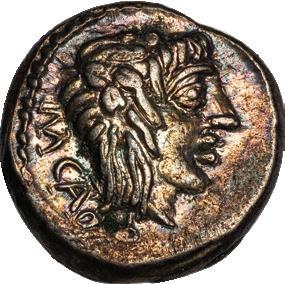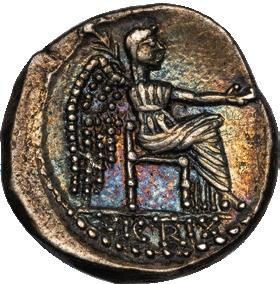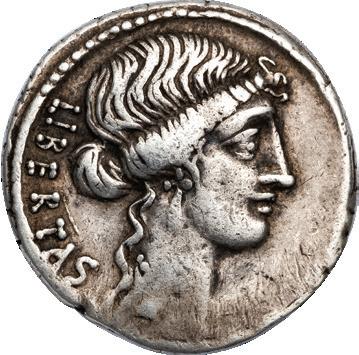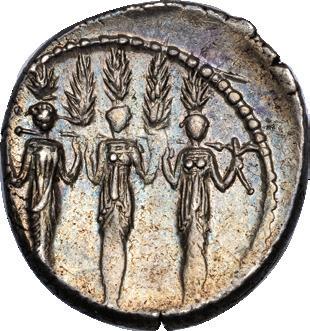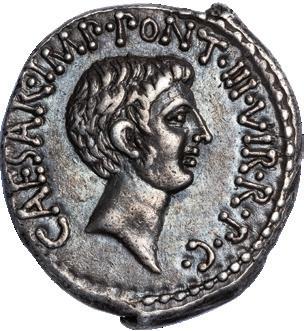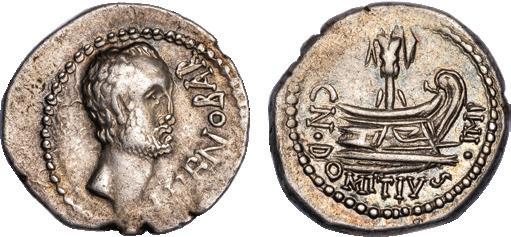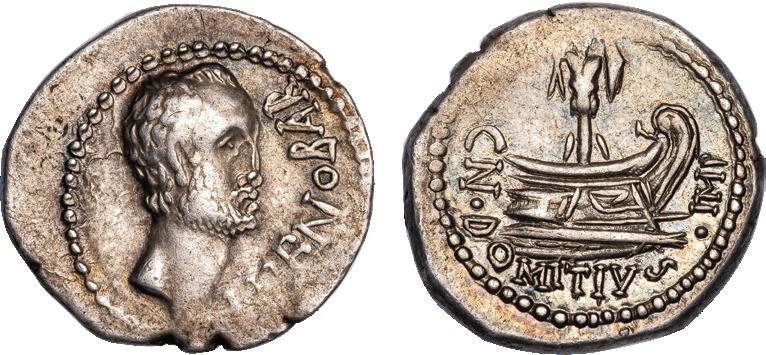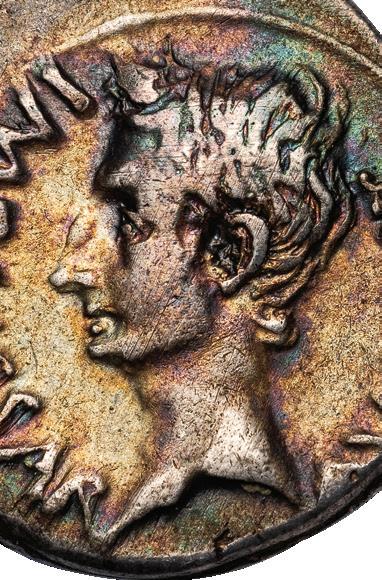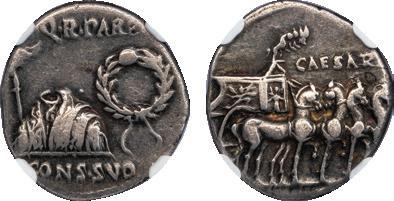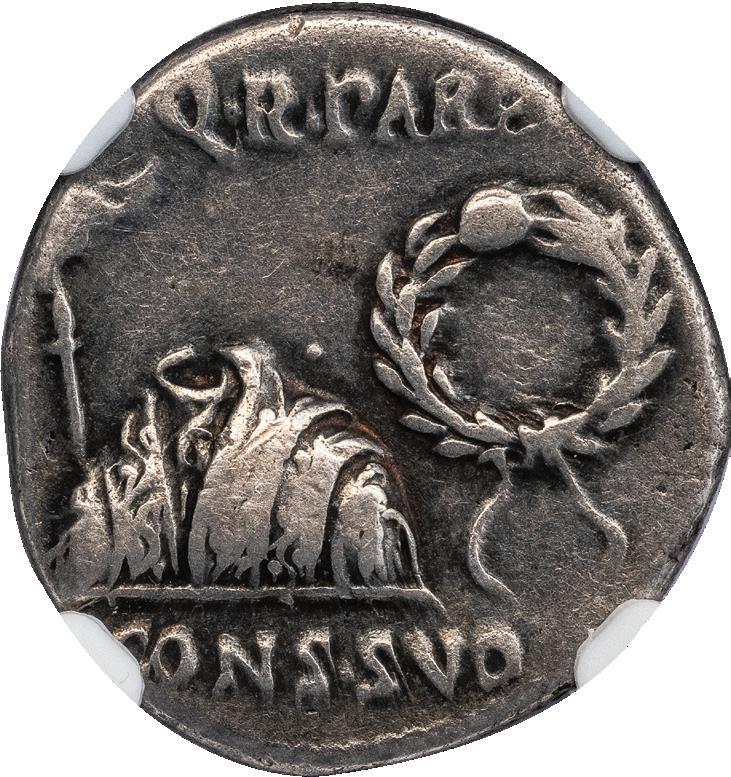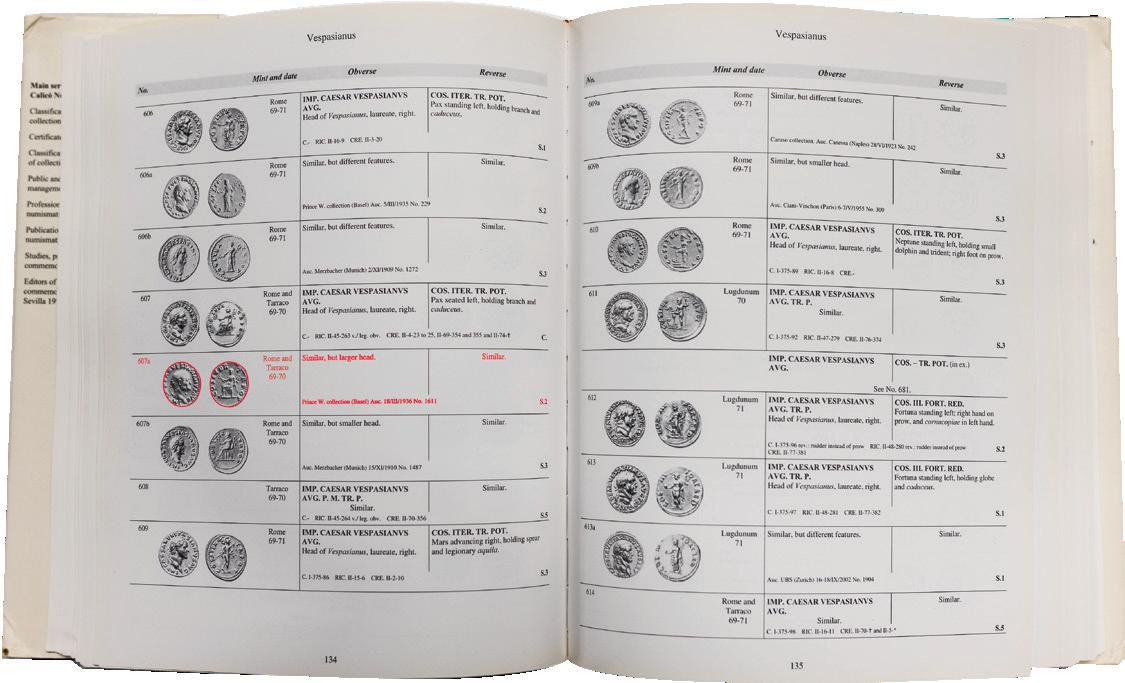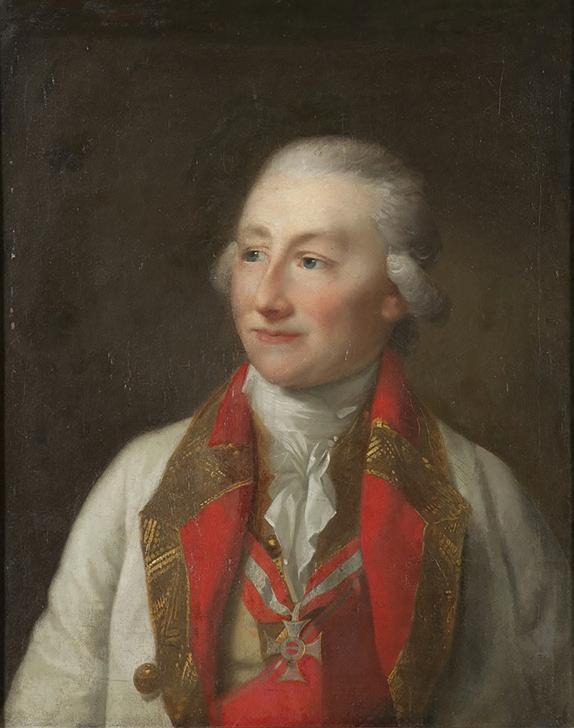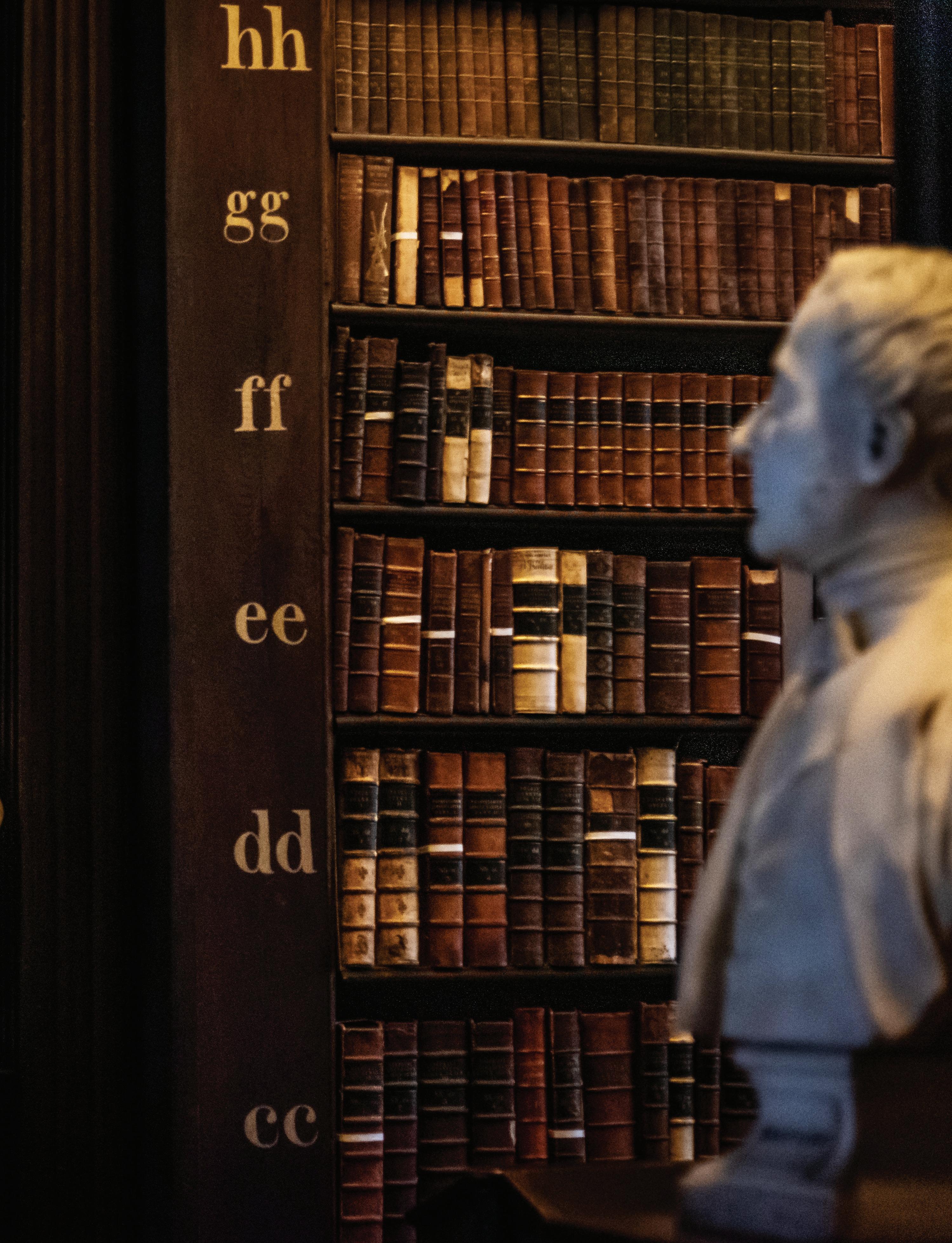SEEMINGLY UNIQUE AND UNPUBLISHED LYSIMACHUS VARIETY FROM A MINT NEAR THE PROPONTIS
18880. KINGDOM OF THRACE. LYSIMACHUS, 305–281 BC.
Silver Tetradrachm, 16.84 g, 33 mm. Late lifetime or early posthumous issue of a mint near the Propontis, ca. 285–270 BC. Obv. Head of deified Alexander the Great right, with the horn of Ammon. Rev. ΒΑΣΙΛΕΩΣ ΛΥΣΙΜΑXΟΥ, Athena enthroned left, holding Nike crowning Lysimachus’ name, caduceus in inner left field, ΘΞΟΡΚ control monogram in exergue, “floating” lion head emblem on shield.
Thompson –; Marinescu 1996 –; Müller –. NGC graded CHOICE XF, Strike 3/5, Surface 4/5, FINE STYLE, “overstruck,” and seemingly unique. $ 4800
This seems to be a variety from a “mystery” mint, documented only by this coin. The caduceus symbol is well known on the coinage of Lysimachus and was often used by the city of Amphipolis. However, the style and appearance of this coin is inconsistent with products from that mint. Rather, it resembles the style often encountered at cities near the Propontis (the area before the Bosporus straits) such as Ainos. The obverse die is known from several examples in the market, and although these bear a caduceus in left field, they have a different control in the exergue (especially an oE monogram). This coin, however, has two very novel features. One is the very complicated control monogram in the exergue which is composed of several letters and is otherwise unattested. Second, is the handling of Athena’s shield boss where the customary lion head is shown “floating” within the oval area rather than projecting out from the surface as befitting a central emblem in relief. This type of lion head is also seen on one of the aforementioned oE varieties (CNG 114, lot 101), but not all. It is also a trademark of certain Lysimachi traditionally placed at Pella, but more recently reattributed to Byzantium (Marinescu, “Byzantium’s Early Coinage in the Name of King Lysimachus: Problems and New Attributions” in Proceedings of the First International Congress of the Anatolian Monetary History and Numismatics, pp. 386–387). Marinescu notes several varieties with this type of lion head, which he calls an “applique lion” since it has that general appearance. On this coin the treatment is the same, and one of the few other instances where the shield boss is rendered in such an imaginative way.


17254. KINGDOM OF THRACE. LYSIMACHUS, 305–281 BC.
Silver Tetradrachm, 17.12 g, 29 mm. Late lifetime or early posthumous issue of an uncertain mint, perhaps Abydus, ca. 285–270 BC. Obv. Head of deified Alexander the Great right, with the horn of Ammon. Rev. ΒΑΣΙΛΕΩΣ ΛΥΣΙΜΑXΟΥ, Athena enthroned left, holding Nike crowning Lysimachus’ name, star in left field. Thompson –, but cf. Thompson 72 for a die engraved in an identical style; cf. Stack’s 6/10/1970, 216, for a similar tetradrachm struck using the same obverse die coupled with a different reverse die.
NGC graded CHOICE AU, Strike 5/5, Surface 4/5, apparently one of two specimens documented. $ 4000
This fascinating variety bears a Macedonian star symbol in left field. The usage of the star is very rare in the Lysimachi series where it generally appears together with other symbols. In this case the style of the obverse is instructive, as dies that look virtually identical and are engraved by the same hand are attested for the mint of Abydus (cf. American Numismatic Society 1944.100.45419).
extremely rare lysimachus variety with a star symbol in left field a rare fourrÉe tetradrachm of lysimachus copying an issue of amphipolis
19259. KINGDOM OF THRACE. LYSIMACHUS, 305–281 BC.
Silver plated “fourrée” Tetradrachm, 13.69 g, 28 mm. Ancient forgery imitating an issue of Amphipolis, ca. 288–281 BC.
Obv. Head of deified Alexander the Great right, with the horn of Ammon. Rev. ΒΑΣΙΛΕΩΣ [Λ]ΥΣΙΜΑXΟΥ, Athena enthroned left, holding Nike crowning Lysimachus’ name, ΠYTΩ control monogram in left field, XAE monogram in outer right field. Thompson 210; Müller 536.
VF, silver plating cracked at several points to reveal the bronze core. Rare, presumably near contemporaneous with the lifetime Amphipolis issue on which it is based. $ 1250
19164. KINGDOM OF MACEDON. ALEXANDER III, THE GREAT, 336–323 BC.
Gold Distater (2 Staters), 17.13 g, 23 mm. Lifetime issue of “Aegae,” ca. 336–323 BC.
Obv. Head of Athena right, wearing large Corinthian helmet with snake ornament below the plume. Rev. ΑΛΕΞΑΝΔΡΟΥ, Nike standing, looking left, holding wreath in right hand and stylis over left shoulder, athlete with raised hands in left field, ΛO control monogram below left wing.
Price 196; Noe, Sycion 9; Lacroix, “Quelque aspects de la numismatique Sicyonienne,” Revue Belge de Numismatique 1964, pp. 52 ff., pl. II, no. 5; ANS 1944.100.29473 (same obverse die).
Ex “Kyrios” Collection, previously ex Collection of a Scottish sea captain, Spink 23007, 10/3/2023, lot 43 = Spink 9026, 10/1/2009, lot 838 = Belgravia Auction Gallery, Malta, 7/1/2009, lot 1133, purchased after the sale.
NGC graded CHOICE XF, Strike 5/5, Surface 4/5, “FINE STYLE,” “edge marks.” This distater type with the athlete figure is quite rare, with only two other specimens in market records of the last 25 years. $ 58500
The male figure used as a symbol on the reverse of this distater has perplexed numismatists over the years. The raised arms have sometimes inspired comparison to the pose of an orator haranguing the crowd while the bent knees have tended to suggest that the figure must be in the act of leaping rather than speech–making. As such, it was sometimes compared to the boy raising a fillet over his head who often appears on Alexander–type coins of Sicyon. Most recently, however, the figure has been thought to represent a wrestler leaping towards his opponent and is commonly considered a participant in the pancratium—the most brutal grappling sport to appear in Greek athletic games.
The pancratium (literally meaning “all power”) combined aspects of wrestling, boxing, but also permitted kicking, choke holds, and joint locks, which made it somewhat akin to modern mixed martial arts. Only biting and eye gouging were forbidden. The pancratium was considered “the best and most manly event in the Olympics” by Philostratus, but it was also used as a military training exercise by the Spartans. The sport is particularly interesting in the Macedonian context of this coin. Doxippus, a former Greek pancratist serving in the army of Alexander the Great was insulted by a Macedonian soldier named Coragus during a banquet. When the situation came close to violence it was agreed that the men would settle their differences in a duel. At the designated time, Coragus appeared fully armed and armored while Doxippus arrived nude and armed only with a club. Thanks to his skill in the pancratium, Doxippus easily defeated Coragus and stood with his foot on his opponent’s throat when Alexander ordered the bout to end. This victory of a Greek over a Macedonian had unfortunate consequences for Doxippus. In revenge for defeating their champion, elements of the Macedonians framed the pancratist for stealing a golden cup. Under the circumstances, Doxippus felt honor bound to commit suicide.


18750. KINGDOM OF MACEDON. CASSANDER, 305–298 BC.
Bronze AE16, 4.11 g, 16 mm. Issue from an Uncertain Mint in Western Asia Minor, 302–301 BC.
Obv. Helmeted head of Athena right. Rev. ΒΑΣΙΛΕΩΣ [Κ]ΑΣΣΑΝΔΡΟΥ above and below club, bowcase in exergue. HGC 3.1, 997.
XF, overstruck over a Macedonian bronze of shield and helmet design, the shield’s outer edge with crescent decorations visible above Athena’s head, pleasing green patina, exceptional for issue. $ 575
19884. THESSALY, LARISSA. Ca. 3rd–2nd CENTURIES BC.
Silver Hemidrachm or Triobol, 2.15 g, 14 mm.
Obv. Head of the nymph Larissa, facing slightly left. Rev. ΛΑΡΙΣ, horse right, preparing to lie down, M control monogram below.
BCD Thessaly II, 340; HGC 4, 514.
Ex Central Texas Collection, acquired from Nilus Coins, inv. 30578, with his ticket. VF, slight granularity, scarce emission with only five specimens of this issue on CoinArchives. This hemidrachm/triobol is a later issue struck to a reduced Aeginetic standard that copies its types from Larissa’s famous full–weight didrachm coinage of the later fourth century BC (see HGC 4, 453–454). $ 285
an overstrike of a leucas pegasus over a heraclean nomos with heracles fighting the nemean lion
18709. ACARNANIA. LEUCAS. Ca. 4th CENTURY BC.
Silver Stater, 8.46 g, 22 mm.
Obv. Pegasus flying left, Λ below. Rev. ΛΕΥ, helmeted head of Athena left, wreath in right field. Pegasi 64; HGC 4, 322; BCD Akarnania –.
XF, overstruck on a Heracles strangling lion nomos type of Lucanian Heraclea (cf. HGC 1, 988); traces of undertype visible on obverse above the Pegasus (lion) and below Pegasus’ neck (Heracles’ club). $ 975
Overstrikes on Corinthian–type host coins are well known for the cities of Tarentum, Metapontum, and Thurium in the third century BC, but the present stater of Leucas is a rare example of Corinthian types struck over a south Italian host. The original Heracleot coin may have been brought back from southern Italy by a northwestern Greek mercenary who had served in the army of Alexander I of Epirus during his campaigns against the Lucanians in 334–331 BC. Heraclea is specifically named as one of the Greek cities saved by Alexander from Lucanian domination in 332 BC. The Achaean weight standard of the south Italian nomos used at Heraclea was tolerably close to that of the Corinthian standard for the much–appreciated Corinthian stater, thus the coin was overstruck at Leucas to make it more viable as a circulating coin in Greece.
19960. ATTICA. ATHENS. Ca. 510/500–480 BC.
Silver Tetradrachm, 17.31 g, 23 mm. Issue of the early Archaic period, ca. 510 BC.
Obv. Helmeted head of Athena right. Rev. ΑΘΕ, owl standing right, head facing, olive sprig in left field, all within incuse square. HGC 4, 1589; Seltman, Group G, plate XII (dies very similar to obverse A182 and associated reverses); Svoronos plate 5, 6; Asyut group 4C.
NGC graded AU, Strike 3/5, Surface 3/5, a high–grade specimen of this early issue. $ 3650
19783. CRETE. GORTYNA. Ca. 4th CENTURY BC.
Silver Drachm, 5.58 g, 21 mm.
Head of Europa right. Rev. Head of bull right within concave field. Svoronos, Crète Ancienne, 92 (same dies) = Mionnet II, 300, I; BMC 38.
Ex Heritage 232433, 8/14/2024, lot 63056 = Coin Cabinet, 5/30/2024, lot 94.
NGC graded CHOICE VF, Strike 3/5, Surface 4/5, “overstruck,” a particularly well struck specimen from high relief dies. $ 2500
17090. MYSIA. CYZICUS. Ca. 550–450 BC.
Electrum Stater, 16.04 g, 21 mm. Issue of 550–500 BC.
Obv. Ram seated left, head looking right, tunny below. Rev. Quadripartite incuse square. Von Fritze 47; Boston MFA 1419.
Ex Siren Collection.
VF, planchet cracks, with an extremely rare square countermark featuring a star. $ 4550
This stater represents a new addition to a very elite club of Cyzicene electrum coins struck in the period c. 550–500 BC and countermarked with an incuse square containing a star of four rays with pellets between the rays. The same punch appears to have been used on staters depicting the forepart of a lioness devouring prey (Von Fritze I, 41) and the forepart of a winged boar (Von Fritze I, 61). The fact that it is also found on a fourrée myshemihekte featuring the head of Perseus (Leu, Web Auction 14, 12/12/2020, 304) suggests that the countermark was probably not applied as a guarantee of value. More likely it served as a banker’s mark, or as a means of indicating ownership.
The star type used for the punch is very suggestive of Miletus, a city that frequently used a stellate pattern on the reverse of its coins in the sixth century BC. However, the Milesian star usually involves four rays with a three–lobed ornament between the rays. Interestingly, the size of the punch and the division of the rays by pellets closely matches the reverse punches used for certain silver hemiobols struck at an uncertain mint in the fifth century BC (e.g., CNG Electronic Auction 287, 9/26/2012, 217). The ultimate origin of the punch remains enigmatic. a high-grade owl from the period of the persian wars
19858. PERGAMENE KINGDOM. ATTALUS I, ca. 241–197 BC.
Silver Tetradrachm of Alexander type, 16.75 g, 32 mm. Issue of ca. 215–220 BC.
Obv. Head of young Heracles right in lion skin headdress. Rev. ΑΛΕΞΑΝΔΡΟΥ, Zeus enthroned left, holding eagle and scepter, palm branch and AI control monogram in left field.
Price –, but cf. Price 1489 for a related variety with a star rather than palm branch, also referenced by Kleiner, “Alexanders of Pergamum and Rhodes,” MN 17, Series XVII, obverse die S = Mektepini Hoard 279 (same obverse).
Ex Jonathan K. Kern Collection = ex Heritage CICF Signature Sale 3032, 4/10/2014, lot 23100.
NGC graded CHOICE XF, Strike 5/5, Surface 4/5, “FINE STYLE,” “[unlisted in M. Price]” and Kern provenance noted on label, dark gray toning with reddish highlights. Dies of exceptional style, the obverse with a particularly sensitive rendering of Heracles’ face that now clearly references Alexander’s physiognomy.
19034. MYSIA. PERGAMUM ( PERGAMON). Ca. 180/167–133 BC.
Silver Cistophorus, 12.56 g, 32 mm. Issue of ca. 160–150 BC.
$ 3000
Obv. Cista mystica within ivy wreath. Rev. Snakes around quiver, ΠEPΓ monogram in left field (for Pergamon), owl standing (horizontally oriented) in right field.
Kleiner–Noe Series 9, 21 (same obverse die as the specimen in the British museum, no. 21a).
NGC graded CHOICE XF, a rare issue with four specimens known to Kleiner–Noe.
$ 875
unlisted in price and with previously unknown control monogram
19836. IONIA. CLAZOMENAE. CIVIC ISSUE IN THE NAME AND TYPES OF ALEXANDER THE GREAT, Ca. 225–180 BC. Silver Tetradrachm of Alexander type, 16.99 g, 33 mm. Issue of ca. 200 BC. Obv. Head of young Heracles right in lion skin headdress. Rev. ΑΛΕΞΑΝΔΡΟΥ, Zeus enthroned left, holding eagle and scepter, forepart of winged boar left above ΠYΘ control monogram in left field. Price –.
NGC graded CHOICE XF, Strike 4/5, Surface 2/5, brushed, “[unlisted in M. Price]” noted on label. $ 1800
The posthumous Alexander coinage of Clazomenae is seldom encountered and Martin Price catalogued only 10 varieties struck over a century (Price 1740–1749). This particular coin features a winged boar forepart, the city’s symbol, and the monogram ΠYΘ, a variety unknown to Price. Given its similarities to issues dated ca. 200 BC (Price 1744–1747) which employ the same winged boar forepart and different monograms, this coin must be part of the emissions from that period. This coin appears to be unique and unpublished.
extremely rare alexander emission of colophon, perhaps second documented specimen
19972. IONIA. COLOPHON. CIVIC ISSUE IN THE NAME AND TYPES OF ALEXANDER THE GREAT, Ca. 215–180 BC. Silver Tetradrachm of Alexander type, 16.98 g, 30 mm. Issue of ca. 200–190 BC. Obv. Head of young Heracles right in lion skin headdress. Rev. ΑΛΕΞΑΝΔΡΟΥ, Zeus enthroned left, holding eagle and scepter, lyre above ME control monogram in left field, ΠA control monogram below throne. Price 1868.
NGC graded CHOICE XF STAR, Strike 5/5, Surface 4/5, “FINE STYLE” noted on label. Extremely rare, perhaps only the second known, the other in the British Museum and referenced by Price and in the Pella database; none in CoinArchives. $ 2000
19961. IONIA. EPHESUS. Ca. 394–325 BC.
Silver Tetradrachm, 15.25 g, 23 mm. Issue of magistrate Artemon, ca. 370–350 BC.
Obv. E–Φ, bee seen from above. Rev. Forepart of stag right, head reverted, palm tree at left, APTEMΩN (magistrate) in right field. Kinns, “Pixodarus Hoard,” in Coin Hoards IX (2002), Class G, p. 204.
NGC graded CHOICE XF, Strike 5/5, Surface 4/5, Artemon is a rarely encountered magistrate with four other specimens in market records and three pieces cited by Kinns. $ 4250
new magistrate for the ephesus bee series unknown to kinns
19550. IONIA. EPHESUS. Ca. 394–325 BC.
Silver Tetradrachm, 15.21 g, 23 mm. Issue of magistrate Aristoleon, ca. 370–360 BC.
Obv. E–Φ, bee seen from above. Rev. Forepart of stag right, head reverted, palm tree at left, APIΣTOΛEΩN (magistrate) in right field. Kinns, “Pixodarus Hoard,” in Coin Hoards IX (2002), unlisted.
NGC graded VF, Strike 4/5, Surface 3/5, Aristoleon is unlisted by Kinns and no other specimens appear in market records. $ 2800
19614. IONIA. EPHESUS. Ca. 394–325 BC.
Silver Tetradrachm, 15.24 g, 23 mm. Issue of magistrate Thrasylochus, ca. 370–360 BC.
Obv. E–Φ, bee seen from above. Rev. Forepart of stag right, head reverted, palm tree at left, ΘPAΣYΛOX[OΣ] (magistrate) in right field. Kinns, “Pixodarus Hoard,” in Coin Hoards IX (2002), Class D, p. 202.
NGC graded VF, Strike 4/5, Surface 4/5, rare magistrate with Kinns listing five specimens and one other appearing in market records. $ 1500
19839. IONIA. ERYTHRAE. CIVIC ISSUE IN THE NAME AND TYPES OF ALEXANDER THE GREAT, late 3rd–early 2nd CENTURIES BC.
Silver Tetradrachm of Alexander type, 16.86 g, 31 mm. Issue of magistrate Epikos, ca. 188–170 BC.
Obv. Head of young Heracles right in lion skin headdress. Rev. ΑΛΕΞΑΝΔΡΟΥ, Zeus enthroned left, holding eagle and scepter, EPY above club and bow in bowcase and EΠI/KOY (magistrate), all in left field.
Price –.
NGC graded CHOICE XF, Strike 4/5, Surface 4/5, “[unlisted in M. Price]” noted on label. $ 1950
The city of Erythrae in Ionia (in present day Turkey) struck civic Alexanders from ca. 290–170 BC (Price 1887–1916). Heracles’ attributes, the club and bow in bowcase, were the city’s symbols and appear together with its abbreviated name EPY on the coinage of ca. 200 BC and after. This coin features these symbols as well as the magistrate’s name EΠIKOY (Epikos). Price recorded varieties like this with different names which were struck ca. 188–170 BC but was not aware of Epikos who is attested for the first time on this coin. Usually, the magistrate names were placed in the exergue of the coin, but here it appears complete in the lower left field.
19838. IONIA. ERYTHRAE. CIVIC ISSUE IN THE NAME AND TYPES OF ALEXANDER THE GREAT, late 3rd-early 2nd CENTURIES BC.
Silver Tetradrachm of Alexander type, 16.90 g, 30 mm. Issue of ca. 215-190 BC.
Obv. Head of young Heracles right in lion skin headdress. Rev. ΑΛΕΞΑΝΔΡΟΥ, Zeus enthroned left, holding eagle and scepter, club and bow in bowcase in left field, forepart of bull at lower left.
Price 1906; Mektepini Hoard 299 (same dies).
NGC graded CHOICE VF, Strike 5/5, Surface 4/5; rare, with two other specimens listed in market records and two others in the Pella database (Münzkabinett Berlin 18252326 and De Nederlandsche Bank, Amsterdam GR-02851). $ 1200
19692. IONIA. MILETUS. CIVIC ISSUE IN THE NAME AND TYPES OF ALEXANDER THE GREAT, ca. 210–190 BC.
Silver Tetradrachm of Alexander type, 16.86 g, 33 mm.
Obv. Head of young Heracles right in lion skin headdress. Rev. ΑΛΕΞΑΝΔΡΟΥ, Zeus enthroned left, holding eagle and scepter, small star above lion looking back above MI control in left field, HPA control monogram below throne.
Price 2168; Mektepini Hoard 391–394 (same obverse as 392); Münzkabinett Berlin 18252359 (same obverse die).
NGC graded CHOICE AU, Strike 3/5, surface 5/5, FINE STYLE, lustrous and struck on a medallic planchet.
19294. IONIA. MILETUS. CIVIC ISSUE IN THE NAME AND TYPES OF ALEXANDER THE GREAT, ca. 190–165 BC.
Silver Tetradrachm of Alexander type, 16.99 g, 29 mm.
$ 1350
Obv. Head of young Heracles right in lion skin headdress. Rev. ΑΛΕΞΑΝΔΡΟΥ, Zeus enthroned left, holding eagle and scepter, small star above lion looking back above MI control in left field, IAI above ME controls in right field.
Price 2212 var.; Münzkabinett Berlin 18252373 (same obverse die).
VF.
$ 975
This tetradrachm is a particularly fascinating coin. Although it is related to Price 2212, the lower right field control monogram appears to be different than the one reported by Price which is a ΠA. It is likely a new “Price unlisted” variety, closely associated with Price 2212 since it shares its obverse die with a coin in Berlin recorded by Price. However, perhaps even more interesting is the engraving’s handling of the exergue line. The rear throne leg is shown extending below the line while the front leg is completely bisected by the line. Under these circumstances one wonders what the engraver thought the exergue line—which he presumably engraved himself—was intended to represent. Clearly, he did not consider it as a visual indicator of the ground.
19989. IONIA. PHOCAEA. Ca. 521–478 BC.
Electrum Hecte, 2.53 g, 10 mm.
Obv. Head of Athena in Archaic style left, Corinthian helmet pulled back over the head. Rev. Quadripartite incuse square. Bodenstedt 41.
Ex Heritage Auctions 3049, 9/8/2016, lot 30144.
NGC graded CHOICE AU, Strike 4/5, Surface 5/5, of particularly refined Archaic style and struck with a fresh obverse die with exceptional detail. $ 3250
19841. IONIA. SMYRNA. CIVIC ISSUE WITH THE TYPES OF ALEXANDER THE GREAT, late 3rd CENTURY BC.
Silver Tetradrachm of Alexander type, 17.06 g, 29 mm. Issue of ca. 220–200 BC.
Obv. Head of young Heracles right in lion skin headdress. Rev. ΑΛΕΞΑΝΔΡΟΥ, Zeus enthroned left, holding eagle and scepter, head of Tyche left above complex MYIAOK control monogram in left field.
Price–, but cf. Price 2257 which illustrates a much simpler version of the control monogram.
NGC graded AU, Strike 5/5, Surface 3/5, “[unlisted in M. Price]” noted on label. A spectacular coin, lustrous, and a variety that was unknown to Martin Price. Seemingly unpublished, and possibly unique as there are no other specimens with this exact control in market records. $ 3500
a new price-unlisted variety using a recut die
19842. ASIA MINOR. UNCERTAIN MINT. CIVIC ISSUE IN THE NAME AND TYPES OF ALEXANDER THE GREAT, ca. 240–180 BC.
Silver Tetradrachm of Alexander type, 16.95 g, 32 mm.
Obv. Head of young Heracles right in lion skin headdress. Rev. ΑΛΕΞΑΝΔΡΟΥ, Zeus enthroned left, holding eagle and scepter, bearded head with calathus left in left field, MIO control monogram in outer left field.
Price –, but cf. Price 2117 (same dies, reverse with different controls); Mektepini Hoard 274 (same obverse, there attributed to Pergamum).
NGC graded CHOICE VF, Strike 5/5, surface 4/5, “(unlisted in M.Price).” $ 1500
This variety was unknown to Martin Price but fits perfectly into a grouping attributed to an uncertain mint in Asia Minor designated by a bearded male head wearing a calathus. The obverse die used here was also employed for Price 2816 and 2817, but more interestingly the reverse die is a recut of one that struck a specimen of Price 2817 (De Nederlandsche Bank, GR–03045, illustrated below). The exergue monogram ΘEY originally on the die was erased (although traces of it remain), and a new control was added in exterior right field. Since the die of the present coin appears in a later state of use, this piece belongs immediately after Price 2817.
De Nederlandsche bank specimen, GR-03045 Inv. 19842
19990. LYDIA. ALYATTES OR WALWET, ca. 610–546 BC.
Electrum Trite (1/3 Stater), 4.72 g, 13 mm. Uninscribed issue of Sardes.
Obv. Head of roaring lion right, “sun disk” on forehead. Rev. Incuse punch with two sections. Linzalone LN1090; Weidauer 89; Kurth G24–G27.
Ex L. William Libbert Collection, Heritage Auctions, Long Beach Signature Sale 378, 6/5/2005, lot 12037.
NGC graded XF, Strike 5/5, Surface 3/5.
19127. PHRYGIA. APAMEIA. Ca. 166–133 BC.
Silver Cistophorus, 29 mm. Issue of ca. 166–160 BC
$ 3700
Obv. Cista mystica within ivy wreath. Rev. Snakes around quiver, AΠ monogram in left field (for Apameia), dolphin right in right field. Kleiner & Noe Series 2 (two specimens listed).
NGC graded XF, “brushed,” some encrustation adhering, a rare issue with no specimens in market records. $ 1350
an unpublished cistophorus of apameia
18920. PHRYGIA. APAMEIA. Ca. 133–67 BC.
Silver Cistophorus, 12.71 g, 27 mm. Issue of ca. 166–160 BC.
Obv. Cista mystica within ivy wreath. Rev. AΠA, snakes around quiver, ΣAT control monogram above, maeander pattern in right field. Kleiner & Noe –, but cf. Kleiner & Noe, Series 5 (Tralles), with the maeander symbol; Kleiner, Late –; Carbone et al, Local Coinages in a Roman World, –.
Ex CNG Electronic Auction 541, 7/28/2023, lot 136.
NGC graded CHOICE XF, Strike 5/5, Surface 3/5, “brushed.” $ 1600
This unpublished and enigmatic cistophoric tetradrachm seems to combine aspects of both early and late cistophori. The style of the serpents appears early and the maeander pattern on the right has parallels in the early cistophoric coinage of Tralles. However, the abbreviated, rather than monogrammatic, treatment of the ethnic is a regular feature of late cistophori. It is a truly remarkable and possibly transitional piece worthy of much further study.
aspendus overstruck over side
18960. PAMPHYLIA. ASPENDUS. Ca. 465–430 BC.
Silver Stater, 10.89 g, 21 mm.
Obv. Helmeted, nude hoplite marching right, holding shield and spear. Rev. ΕΣT, triskeles, all within incuse square.
SNG Paris 6; SNG von Aulock 4477; SNG Copenhagen –.
Good VF, overstruck over a stater of Side, ca. 460–430 BC. Trace of the undertype’s obverse, the pomegranate within a guilloche border, are visible on the obverse while the undertype’s Athena head can partially be discerned on the reverse. $ 475
aspendus overstruck over phaselis
14840. PAMPHYLIA. ASPENDUS. Ca. 465–430 BC.
Silver Stater, 10.86 g, 19 mm.
Obv. Helmeted, nude hoplite marching right, holding shield and spear. Rev. ΕΣT, triskeles, all within incuse square.
SNG Paris –; SNG von Aulock –; SNG Copenhagen 175.
Fine, overstruck over a stater of Phaselis, Lycia, ca. 500–440 BC, the undertype’s galley stern being especially visible under the triskeles, a seldom–encountered undertype for this series. $ 550
aspendus overstruck over celendris and chronological issues
14899. PAMPHYLIA. ASPENDUS. Ca. 465–430 BC.
Silver Stater, 10.80 g, 23 mm.
Obv. Helmeted, nude hoplite marching right, holding shield and spear. Rev. ΕΣT, triskeles, all within incuse square.
SNG Paris –; SNG von Aulock –; SNG Copenhagen 175.
Near VF, overstruck over a stater Celenderis, Cilicia, generally dated ca. 430–420 BC, the host being particularly clear on both sides of the coin. Staters of Celenderis are infrequently overstruck at Aspendus and this overstrike appears to impact the currently established chronology as the Celenderis issue should be earlier given its reuse here. $ 850
14804. PAMPHYLIA. ASPENDUS. Ca. 465–430 BC.
Silver Stater, 10.88 g, 21 mm.
Obv. Helmeted, nude hoplite marching right, holding shield and spear. Rev. ΕΣT, triskeles, all within incuse square.
aspendus overstruck on aegina a possible triple overstrike of an aspendus stater on lyttus, crete
SNG Paris 12; SNG von Aulock –; SNG Copenhagen 175. VF, overstruck at least once over a coin with a flying eagle right (cf. a Lyttus, Crete specimen in Le Rider, Crétoises, p. 101, no. 5, pl. XXV, 15) and likely another, earlier coin, whose incuse square appears rotated some 15 degrees relative to the other two (Aspendus and Lyttus) that overlap. Since Cretan coins were often overstruck on other issues from the island, this multiple overstrike could be as follows: Aspendus over Lyttus over another Cretan piece. $ 1200
17577. PAMPHYLIA. ASPENDUS. Ca. 465–430 BC.
Silver Stater, 10.91 g, 20 mm.
Obv. Helmeted, nude hoplite marching right, holding shield and spear. Rev. ΕΣT, triskeles, all within incuse square.
SNG Paris 13; SNG von Aulock –; SNG Copenhagen –.
Good VF, overstruck on a stater of Aegina, likely HGC 6, 435 (ca. 470/65–445/40 BC), the undertype’s skew? pattern visible on the reverse. $ 950
19743. PAMPHYLIA. ASPENDUS. Ca. 380–325 BC.
Silver Stater, 10.89, g, 24 mm.
Obv. Two wrestlers in combat. Rev. [EΣΤF]EΔΙΙΥΣ, slinger to right, ready to shoot, triskeles in right field, all within dotted square. Tekin Series 3; SNG Paris 53.
NGC graded CHOICE AU, Strike 3/5, Surface 4/5, strike a bit weak on obverse, but exceptional detail on the slinger. $ 950
19533. PAMPHYLIA. SIDE. 3rd–2nd centuries BC.
Silver Tetradrachm, 16.60 g, 29 mm.
Obv. Head of Athena right, wearing Corinthian helmet. Rev. Nike moving left, offering wreath, pomegranate above Corinthian helmet left and AP control monogram in left field.
Seyrig, Side, 3. SNG Paris 667–8.
Good VF, matte gray toning, punch mark (?) on helmet.
a very rare nagidus issue overstruck on a celenderis stater
17576.CILICIA. NAGIDUS. Ca. 375–365 BC.
Silver Stater, 10.75 g, 25 mm.
$ 750
Obv. Aphrodite enthroned left, holding phiale in right hand and resting left arm on throne back; Eros standing left behind. Rev. [N] AΓIΔE[ΩN], Dionysus standing left, holding grape bunch in right hand and thyrsus in left.
P. Lederer, “Die Staterprägung der Stadt Nagidos,” ZfN 41 (1931), Gruppe V, 21; cf. SNG Paris 24–26 (different arrangement of legend and control letter); SNG Levante –; BMC –.
Ex Vilmar Numismatics FPL VI (Winter 2023), no. 49.
NGC graded AU, Strike 3/5, Surface 4/5, “overstruck,” “undertype: Celenderis.” This is an extremely rare issue of Nagidus known to Lederer from only two specimens: one in the Berlin Münzkabinett and the other in the Hunterian Collection. It is overstruck on a horseman/goat stater of Celenderis (cf. Casabonne Type 4), with traces of horseman’s head and dotted border appearing above and to the right of Dionysus’ head. $ 1750
19807. SELEUCID KINGDOM. ANTIOCHUS HIERAX, ca. 242–227 BC.
Silver Tetradrachm, 16.50 g, 31 mm. Issue of Alexandria Troas.
Obv. Winged diademed head of idealized king right, with heavy features and slightly aquiline nose, perhaps a portrait of Antiochus I. Rev. BAΣIΛEΩΣ ANTIOXOY, Apollo seated left on omphalos, holding arrow in right hand and resting left hand on grounded bow, horse grazing left flanked by two control monograms in exergue.
SC 878.2; WSM 1575γ–η (same dies); HGC 9, 399g.
NGC graded CHOCE VF, Strike 5/5, Surface 3/5. $ 875
19796. PHOENICIA. TYRE.
Silver Shekel, 14.21 g, 27 mm. Issue dated Tyre year 105 (22/1 BC).
Obv. Laureate head of Melkart right. Rev. ΤΥΡΟΥ
ΘE control monogram in right field, Phoenician letter B between legs.
eagle standing left on prow, PE (date) above club in left field,
DCA Tyre Supplement Release 2, –, cf. 375–379 (with different control monograms).
NGC graded CHOICE VF, Strike 5/5, Surface 4/5. $ 3000
There are five varieties of year 105 listed by Cohen, his nos. 375–379. He was unaware of a year 105 variety with control ΘE as on this coin. However, Cohen did know of ΘE used in the following year, 106 (21/0 BC), struck using the same obverse die as here. Therefore, it is clear that the control monogram ΘE was among the very last to be employed for year 105 and the first to appear in 106.
19297. PHOENICIA. TYRE.
Silver Shekel, 14.27 g, 22 mm. Issue dated Tyre year 157 (AD 31/2), struck DURING THE LIFETIME OF CHRIST.
Obv. Laureate head of Melkart right. Rev. ΤΥΡΟΥ
eagle standing left on prow, PNZ (date) above club in left field, KP above control monogram in right field, uncertain Phoenician letter between legs.
DCA Tyre Supplement Release 2, 565 (same obverse die).
Ex Stack’s Bowers, 10/22/ 2019, lot 71029.
NGC graded CHOICE VF, Strike 3/5, Surface 4/5, rare date with only six specimens appearing in market records; the date of the coin is about one to two years before the traditional date of Christ’s Crucifixion. $ 1950
18170. PHOENICIA. TYRE.
Silver Shekel, 12.51 g, 24 mm. Issue dated Tyre year 161 (AD 35/6).
Obv. Laureate head of Melkart right. Rev. ΤΥΡΟΥ
eagle standing left on prow, PΞA (date) above club in left field, KP above XE monogram in right field, Phoenician letter A? between legs.
DCA Tyre Supplement Release 2, 591–592.
NGC graded CHOICE AU, Strike 3/5, Surface 3/5. $ 2500
the aspiring assassin, brutus as moneyer
18332. ROMAN IMPERATORIAL. M. JUNIUS BRUTUS, d. 42 BC.
Silver Denarius, 3.98 g, 17 mm. Issue of Rome, struck by Brutus while he served as moneyer, 54 BC. Obv. LIBERTAS, head of Libertas right. Rev. BRVTVS, procession of L. Junius Brutus, consul of 509 BC, and lictors.
Crawford 433/1; Sydenham 906.
Ex Freeman & Sear, Mail Bid Sale 13, 8/25/2006, lot 348.
NGC graded AU, Strike 3/5, Surface 2/5, “graffito,” “edge cut,” light gray toning with light blue iridescent highlights. $ 1950
18982. ROMAN IMPERATORIAL. CASSIUS, d. 42 BC.
Silver Denarius, 3.53 g, 18 mm. Issue of P. Cornelius Lentulus Spinther as legate, struck at a military mint, perhaps Smyrna, from 42 BC. Obv. C. CASSI IMP, tripod with cauldron (cortina) above. Rev. LENTVLVS / SPINT, capis and lituus.
Crawford 500/1; Sydenham 1308.
Ex Vilmar Numismatics FPL VI (Winter 2023), no. 71.
NGC graded MINT STATE, Strike 5/5, Surface 4/5, with golden iridescent highlights on the obverse. A historical coin as Cassius was one of the “Liberators,” the group of Romans who planned and carried out the assassination of Julius Caesar on the Ides of March. $ 3650
18419. ROMAN IMPERATORIAL. MARC ANTONY AND OCTAVIAN.
Silver Denarius, 3.89 g, 18 mm. Issue of M. Barbatius Pollio, struck at Ephesus, 41 BC. Obv. M ANT IMP AVG IIIVIR R P C M BARBAT Q P, bare head of Marc Antony right. Rev. CAESAR IMP PONT IIIVIR R P C, bare head of Octavian right.
Crawford 517/2; Sydenham 1181.
NGC graded CHOICE VF, Strike 4/5, Surface 4/5, “marks,” light gray toning with reddish highlights, a coin depicting portraits of Antony and Octavian, the final two great adversaries in the Roman Civil War that created the Empire. $ 2250
19778. ROMAN IMPERATORIAL. JULIUS CAESAR, d. 44 BC.
Silver Denarius, 3.82 g, 18 mm. Issue of a military mint traveling with Caesar, 49–48 BC.
Obv. CAESAR, elephant to right, trampling serpent. Rev. Emblems of the Pontifex Maximus – simpulum, aspergillum, securis and apex. Crawford 443/1; Sydenham 1006.
NGC graded CHOICE VF, Strike 4/5, Surface 4/5.
$ 2450
The reverse types of this denarius, struck just after the outbreak of civil war between Julius Caesar and Pompey the Great, clearly advertises Caesar’s role as pontifex maximus. However, the intended meaning of the obverse type has remained a mystery to numismatists down to the present day. It has been variously interpreted as an allegory of the triumph of good over evil, or a reference to Caesar’s victories in Gaul.
19962. ROMAN EMPIRE. AUGUSTUS, 27 BC–14 AD.
Gold Aureus, 7.83 g, 19 mm. Issue of Lugdunum (Lyon), 2 BC–AD 4.
Obv. CAESAR AVGVSTVS DIVI F PATER PATRIAE, laureate head of Augustus right. Rev. AVGVSTI F COS DESIG PRINC IVVENT, Gaius and Lucius Caesars, standing facing, holding grounded shields and spears, lituus and simpulum in upper field, C L CAESARES in exergue.
RIC I rev 209; Calicó 177a.
NGC graded CHOICE VF, Strike 4/5, Surface 3/5, with an imposing and elegant portrait of Augustus.
$ 9750
In 23 and 18 BC, Augustus greatly increased the constitutional powers given to his loyal lieutenant and son–in–law, M. Vipsanius Agrippa, with the intention of ultimately passing on the role of emperor to him. Unfortunately, he died prematurely in 12 BC, leaving Augustus to look for new heirs. Despite their youth, Augustus decided to name his grandsons Gaius and Lucius Caesar as his official heirs in 2 BC. This coin celebrates their assumption of the toga virilis—the garment of an adult roman citizen—and the title of principes iuventutis (“princes of the youth”) in 2 BC in order to advertise the security of the imperial succession. Unfortunately, like their father Agrippa, they were also destined to die before they could succeed the ailing but long–lived Augustus. Lucius fell ill and died while travelling to Hispania in AD 2. Some 18 months later, Gaius also succumbed to illness while making his way through Lycia.
Inv. 19111
Inv. 19031
19111. ROMAN EMPIRE. AUGUSTUS, 27 BC–AD 14. Silver Denarius, 3.96 g, 18 mm. Issue of a mint in Spain (perhaps Colonia Caesaraugusta), ca. 19–18 BC.
Obv. CAESAR AVGVSTVS, head of Augustus right, wearing the oak crown (corona civica). Rev. DIVVS IVLIV[S], comet with tail upward.
RIC I rev 102.
Ex Áureo & Calicó 367, 6/2/2021, lot 2068.
NGC graded CHOICE VF, Strike 4/5, Surface 4/5. $ 3500
This famous type depicts the comet that appeared in July of 44 BC. Octavian interpreted the celestial event as a sign confirming the transition of Caesar’s spirit to the divine sphere, proclaiming it to be the “Sidus Iulium” (“Caesar’s star”). In his Metamorphoses XV, 745–842, the poet Ovid rhapsodized the comet: “Jupiter hardly had pronounced these words, when kindly Venus, although seen by none, stood in the middle of the Senate–house, and caught from the dying limbs and trunk of her own Caesar his departing soul. She did not give it time so that it could dissolve in air, but bore it quickly up, toward all the stars of heaven; and on the way, she saw it gleam and blaze and set it free. Above the moon it mounted into heaven, leaving behind a long and fiery trail, and as a star it glittered in the sky.” (Brookes More translation, 1922)
19031. ROMAN IMPERATORIAL. OCTAVIAN (AUGUSTUS), 27 BC–AD 14.
Silver Denarius, 3.52 g, 20 mm. Issue of an Italian mint, ca. 32–31 BC.
Obv. Head of Augustus right. Rev. CAESAR DIVI F, Venus to right, seen from the back, holding helmet and scepter and leaning on column to her left; shield with comet at lower left, propped against column.
RIC I rev 250a.
NGC graded VF, Strike 5/5, Surface 4/5, a scarce denarius variety. $ 3250
On this coin Octavian proclaims himself to be the “son of the divine Julius” and depicts Venus, the divine progenitor of the Julian clan. The goddess gazes at the helmet of her lover Mars, who was considered to have aided Octavian at the battle of Philippi, while his shield bears a stellar symbol, almost certainly the comet (sidus Iulium) symbolizing the deification of Caesar, Octavian’s adoptive father. The noted German art historial Paul Zanker, in his book The Power of Images in the Age of Augustus, illustrates this type of denarius twice (figs. 27c and 41b) and comments on the importance of the coin: “His protectress is Venus Genetrix...who regards the arms of Mars, with the sidus Iulium blazing on the shield.” (Zanker, p. 53).
19981. ROMAN EMPIRE. TIBERIUS, AD 14–37.
Silver Denarius, 3.60 g, 17 mm. Issue of Lugdunum (Lyon).
Obv. [T]I CAESAR DIVI AVG F AVGVST[VS], laureate head of Tiberius right. Rev. PONTIF MAXIM, female figure (Livia as Pax) enthroned right, holding scepter and olive branch.
RIC I rev 30.
NGC graded MINT STATE, Strike 5/5, Surface 2/5, among the 27 top graded MS specimens currently in the NGC census (25 MS, 2 MS Star). $ 4500
Under Tiberius, this coin type has gained fame among numismatists for its probable involvement in the New Testament account of Jesus being questioned by the Pharisees and Herodians about the legitimacy of paying taxes to Rome. Although their intention was to get him to speak against the Romans and thereby obtain an excuse for his arrest, Matthew 22:19–21 reports that he responded to his questioners by saying, “‘Show Me the coin used for the poll–tax.’ And they brought Him a denarius. And He said to them, ‘Whose likeness and inscription is this?’ They said to Him, ‘Caesar’s.’ Then He said to them, ‘Then render to Caesar the things that are Caesar’s; and to God the things that are God’s.’ And hearing this, they were amazed, and leaving Him, they went away.”
19366. ROMAN EMPIRE. NERO, AD 54–68.
Silver Denarius, 3.57 g, 19 mm. Issue of Lugdunum (Lyon), AD 58–59.
Obv. NERO CAESAR AVG IMP, youthful head of Nero right. Rev. PONTIF MAX TR P [V P P], EX S C within oak wreath (corona civica).
RIC I rev 17 (R2).
NGC graded CHOICE XF, Strike 4/5, Surface 3/5, “brushed,” lustrous, with areas of blue iridescence on the obverse and a well–realized portrait of the young emperor. $ 4800
On this coin the young Nero adopts a famous Roman coin type showing the corona civica, an oak wreath awarded by the Senate in 27 BC to Augustus. Under the Roman Republic, this oak wreath was awarded for saving the life of a citizen in war, but it was presented to Augustus for saving all Roman citizens from civil war by defeating Mark Antony and assuming sole power. Here, Nero attempts to style himself a “new” Augustus by adopting his coin type.
19861. ROMAN EMPIRE. TITUS, AD 79–81.
Silver Denarius, 3.28 g, 20 mm. Issue of Rome, struck while serving as Caesar, AD 74.
Obv. T CAESAR IMP VESPASIAN, laurate head of Titus right. Rev. PONTIR TR P COS III, winged caduceus.
RIC II.1 706.
NGC graded AU, Strike 4/5, Surface 4/5, with an exceptional portrait of Titus; this variety is a rare emission, with only six other specimens in market records. $ 1350
19965. ROMAN EMPIRE. DOMITIAN, AD 81–96.
Gold Aureus, 7.26 g, 19 mm. Issue of Rome, struck while serving as Caesar, AD 77–78.
Obv. DOMITIANVS CAESAR AVG F, laureate head of Domitian right. Rev. CERES AVGVST, Ceres standing, looking left, holding grain ears and scepter.
RIC II.1 975 (Vespasian); Calicó 815.
Ex Editions V. Gadoury, Auction 2014, 12/6/2014, lot 114.
NGC graded CHOICE VF, Strike 4/5, Surface 3/5.
19016. ROMAN EMPIRE. DOMITIAN, AD 81–96.
Silver Denarius, 3.49 g, 19 mm. Issue of Rome, AD 92–93.
$ 7000
Obv. IMP CAES DOMIT AVG GERM P M TR P XII, laureate head of Domitian right. Rev. IMP XXII COS XVI CENS P P P, Minerva advancing right on capital of rostral column, holding raised spear and shield, owl at her feet.
RIC II.1 740.
Ex Numismatik Naumann 48, 11/20/2016, lot 561.
NGC graded CHOICE XF, Strike 5/5, Surface 3/5, exceptionally well struck, with violet highlights and beautiful dark gray cabinet toning. $ 1200
19929. ROMAN EMPIRE. VALENTINIAN II, AD 375–392.
Gold Solidus, 4.47 g, 21 mm. Issue of Constantinople, officina Θ, struck AD 388–392.
Obv. D N VALENTINIANVS P F AVG, diademed, draped and cuirassed bust right. Rev. CONCORDIA AVGGG Θ, Constantinopolis, enthroned, looking right, holding scepter and globe, CONOB in exergue. RIC IX 46d.4; Depeyrot 45/2.
NGC graded CHOICE AU, Strike 5/5, Surface 2/5, “graffiti,” “brushed.”
superb choice mint state 5-5 5-5 theodosius II gold solidus
19932. EASTERN ROMAN EMPIRE. THEODOSIUS II, AD 402–450.
Gold Solidus, 4.45 g, 20 mm. Issue of Constantinople, officina Θ, AD 441.
$ 2250
Obv. D N THEODOSIVS P F AVC, diademed, helmeted and cuirassed bust of Theodosius three quarters right, holding spear and shield with horseman device. Rev. VIRT EXERC ROM, soldier, in military garb, holding trophy on shoulder and dragging captive right, star in right field, CONOB in exergue, officina Θ.
RIC X 284.
NGC graded CHOICE MINT STATE, Strike 5/5, Surface 5/5, an exceptional NGC grade with perfect strike and surface numbers.
$ 5700
19952. EASTERN ROMAN EMPIRE. THEODOSIUS II, AD 402–450.
Gold Solidus, 4.47 g, 21 mm. Issue of Constantinople, officina Γ.
Obv. D N THEODOSIVS P F AVC, diademed, helmeted and cuirassed bust of Theodosius three quarters right, holding spear and shield with horseman device. Rev. GLOR ORVIS TERRAR Γ, Theodosius standing facing, dressed in military cuirass, holding labarum and cross on globe (globus cruciger), star in left field, CONOB in exergue. RIC X 232; Depeyrot 77/1.
NGC graded MINT STATE, Strike 5/5, Surface 3/5, “brushed,” a scarce type for Constantinople, the officina Γ issue is a rare emission with six specimens recorded in market records. $ 1950
This is the first appearance of the “globus cruciger,” a globe with a cross on top, held by the emperor, imagery that becomes standard in the numismatic repertoire of the Western world. The legend “GLORY OVER THE ENTIRE WORLD” may refer to the globus cruciger and its symbolism, namely that Christianity, represented by the cross, has spread over the entire known world.
19933. EASTERN ROMAN EMPIRE. AELIA EUDOCIA, WIFE OF THEODOSIUS II, AD 423–460.
Gold Tremissis, 1.30 g, 14 mm. Issue of Constantinople.
Obv. AEL EVDOCIA AVC, diademed and draped bust of Eudocia right. Rev. Cross within wreath, CONOB* in exergue.
RIC X 253 (Theodosius II); Depeyrot 72/2.
Ex. Harlan J. Berk (inventory cc57189), sold in the early 2000s, with old label.
NGC graded CHOICE VF, Strike 5/5, Surface 2/5, “graffito,” “marks,” “clipped” noted. $ 1450
19966. EASTERN ROMAN EMPIRE. LEO I, 457–474 AD.
Gold Solidus, 4.38 g, 21 mm. Issue of Constantinople, officina Z, struck AD 462–466.
Obv. DN LEO PERPET AVC, diademed, helmeted and cuirassed bust of Leo facing slightly right, holding spear and shield with horseman device. Rev. VICTORIA AVCCC Z, Victory standing left, holding jeweled cross, star in right field, CONOB in exergue. RIC X 605.
Ex Harlan J. Berk, Buy or Bid Sale 179, 5/24/2012, lot 52, (with old dealer ’s ticket).
NGC graded CHOICE MINT STATE, Strike 5/5, Surface 4/4, “clipped,” well struck and with great visual appeal. $ 3200
19595. BYZANTINE EMPIRE. CONSTANS II WITH CONSTANTINE IV, AD 654–688.
Gold Solidus, 4.36 g, 19 mm. Issue of Constantinople, officina Δ, struck AD 654–668.
Obv. CONSTANTINЧS C CONSTANTINI, crowned and draped busts of Constans and Constantine, facing, cross above. Rev. VICTORIA–AVϚЧ Δ, cross potent on three–stepped base, CONOB below. Sear 959.
NGC graded MINT STATE, Strike 4/5, Surface 4/5, “clipped.” $ 1150
19527. BYZANTINE EMPIRE. ROMANUS III, AD 1028–1034.
Gold Histamenon Nomisma, 4.30 g, 24 mm. Issue of Constantinople.
Obv. +IhS XIS RЄX RЄGNANTIЧM, Christ enthroned, facing, holding Gospels and raising his right hand in benediction. Rev. ΘCE ΒΟΗΘ ΡωΜΑΝω, Virgin standing on right, facing, crowning Romanus on left, Μ–Θ above. Sear 1819.
NGC graded CHOICE AU, Strike 5/5, Surface 4/5, “clipped.” $ 2250
19645. BYZANTINE EMPIRE. CONSTANTINE IX, AD 1042–1055.
Gold Histamenon Nomisma (scyphate), 4.31 g, 29 mm. Issue of Constantinople.
Obv. +IhS XIS RЄX RЄGNANTIhM, Christ enthroned, facing, holding Gospels and raising his right hand in benediction. Rev. +CωNSτANτIN bASILЄЧS, bearded bust of the emperor, holding labarum and globus cruciger. Sear 1829.
NGC graded AU, Strike 5/5, Surface 3/5, “edge crimps,” “light marks,” an exceptional strike on a large, medallic planchet. $ 1950
19602. BYZANTINE EMPIRE. CONSTANTINE X, AD 1059–1067.
Gold Histamenon Nomisma (scyphate), 4.40 g, 26 mm. Issue of Constantinople.
Obv. +IhS XIS RЄX RЄGNANTIЧM, Christ enthroned, facing, holding the Gospels. Rev. +KωN RAC Λ O ΔOVKAC, Constantine, standing, holding globus cruciger and labarum with pellet on the shaft. Sear 1847.
NGC graded AU, Strike 5/5, Surface 4/5, a coin with a deep golden toning that gives it a phenomenal eye appeal and a remarkably detailed portrait of Jesus Christ. $ 1500
19813. BYZANTINE EMPIRE. JUSTINIAN I, AD 527–565.
Bronze Follis/40 Nummi, 22.47 g, 39 mm. Issue of Nicomedia, officina B, struck Regnal Year 13 (AD 539/40).
Obv. Helmeted and cuirassed facing bust, holding globus cruciger and shield, cross in right field. Rev. M between A/N/N/O and X/II/I, cross above, B below, NIK in exergue. Sear 201.
NGC graded AU, Strike 5/5, Surface 5/5, a wonderful and well–struck specimen. $ 550
among the top graded anonymous folles of class a2
19798. BYZANTINE EMPIRE. ANONYMOUS ISSUE.
Bronze Follis, 10.47 g, 28 mm. Issue of Constantinople, ca. AD 976–1035 (Class A2).
Obv. + ЄMMANOVHΛ / IC–XC, bust of Christ Pantocrator, facing, holding Gospels and raising his right hand in benediction. Rev. + IҺSЧS / XRISTЧS / bASILЄЧ / bASILЄ (Jesus Christ, King of Kings).
Sear 1813.
NGC graded MINT STATE STAR, Strike 5/5, Surface 5/5, superb in every way, beautifully preserved and with an icon–like representation. This coin is among the currently top graded pieces of Class A2, six in MS Star with none higher. Given it’s double 5/5 rating it probably is the very best of the six. $ 1950
19701. BYZANTINE EMPIRE. ANONYMOUS ISSUE.
Bronze follis, 8.60 g, 27 mm. Issue of Constantinople, ca. AD 1020-1028 (Class A3).
Obv. + ЄMMANOVHΛ / IC-XC, bust of Christ Pantocrator, facing, holding Gospels and raising his right hand in benediction. Rev. + IҺSҺ / XRISTЧ / bASILЄЧ / bASILЄ (Jesus Christ, King of Kings).
Sear 1818.
NGC graded CHOICE AU STAR, Strike 5/5, Surface 4/5, with an interesting variant spelling for Jesus in the reverse legend and a wonderful portrait; among the 11 top coins with STAR designation, 5 in CH AU like this specimen and 6 in MS. $ 1250
FPL VIII – PART II
A CENTURY OF COLLECTING:
ancient coins pedigreed to ca. 1900 - 2000
18493. CALABRIA. TARENTUM. Ca. 281–240 BC.
Silver Didrachm (Nomos), 6.36 g, 21 mm. Issue of magistrate Philiscus.
Obv. Youthful rider right, crowning his horse, ΦΙΛICKOC below. Rev. TAPAΣ, dolphin rider left, holding cantharus, tripod below. HGC 1, 891; Vlasto 888; HN Italy 1036.
Ex Salton Collection = Mark M. Salton–Schlesinger FPL 17 (undated, ca. 1952), lot 49 (not illustrated, but almost certainly this coin), Vilmar Numismatics FPL V (Summer/Fall 2023), no. 2.
NGC graded VF, Strike 4/5, Surface 3/5, “graffito” (letter A on reverse) noted, dark gray cabinet patina.
$ 750
The reverse type of Tarentum’s coinage has been variously described as representing Taras, the son of Poseidon and eponymous founder of Tarentum, or Phalanthus, the semi–legendary leader of the group of Spartan colonists that set out to settle at Tarentum in ca. 708 BC. The colonists had been instructed by the Delphic Oracle to establish a new city in southern Italy, but Phalanthus was shipwrecked on the way. Not wishing his oracle’s prophecy to be shown as false, the god Apollo sent a dolphin to save Phalanthus from drowning and to lead the colonists to the site of the new settlement.
17696. CALABRIA. TARENTUM. C. 272–240 BC.
Silver Didrachm (Nomos), 6.52 g, 18mm. Issue of magistrate Philotas.
Obv. Youthful rider left, crowning his horse; ΔI to right, ΦIΛΩ/TAΣ in two lines below. Rev. TAPAΣ, dolphin rider left, holding cantharus and distaff, cock left in right field.
HGC 1, 889 var. (different symbol and rider attribute); Vlasto 846; HN Italy 1024.
Ex Kermit C. Smyth Collection. Ex Coin Galleries, 7/17/1996, lot 1320.
NGC graded AU, Strike 5/5, Surface 4/5.
18494. CALABRIA. TARENTUM. Ca. 280–240 BC.
Silver Didrachm (nomos), 6.35 g, 21 mm. Issue of magistrate Hippoda.
Obv. Youthful rider right, |–IΠΠOΔA below. Rev. TAPAΣ, dolphin rider left, holding cantharus, amphora and ΔI in left field.
HGC 1, 894; Vlasto 904–906; HN Italy 1040.
Ex Salton Collection, likely acquired in the 1950s–1960s when Mr. Salton owned a numismatic firm in New York.
NGC graded CHOICE VF, Strike 4/5, Surface 3/5, colorful iridescent highlights.
$ 875
$ 675
a scarce diobol once owned by michel vlasto and plated in his work
19753. CALABRIA. TARENTUM. Ca. 380–280 BC.
Silver Diobol, 1.12 g, 12 mm.
Obv. Helmeted head of Athena left, with Scylla ornament on helmet. Rev. TAPAΣ, Heracles struggling with the Nemean lion, Σ below. Vlasto 1237 (this coin published and illustrated); HN Italy 914.
VF, a scarce variety with ten specimens in market records. $ 1250
from the salton-schlessinger fpl of 1953
17464. LUCANIA. HERACLEA. Ca. 281–250 BC.
Silver Stater (Nomos), 6.65 g, 21 mm.
Obv: I–HPAKΛHIΩN, head of Athena right, wearing large Corinthian helmet decorated with rampant griffin ornament, I–H in left field.
Rev. Heracles standing left, holding club and sacrificing above flaming altar, thunderbolt in right field.
HGC 1, 1007, Van Keuren 136; HN Italy 1433.
Ex Salton Family Collection, Vilmar Numismatics FPL III (2022), no. 6 = Mark M. Salton–Schlessinger FPL 19, 2/17/1953, lot 24. NGC graded CHOICE XF, Strike 5/5, Surface 5/5, steel gray old cabinet toning with golden iridescent highlights. $ 2500
17756. LUCANIA. METAPONTUM. Ca. 330–280 BC.
Silver Stater, 7.66 g, 20 mm.
Obv. Wreathed head of Demeter facing three quarters right, AΠ in right field. Rev. META, ear of grain, facing bull’s head and ΑΘ[Α] in right field.
Johnston, Metapontum, Class C, 2.7 (same dies); Pozzi Collection 196 (this coin listed and illustrated); SNG Lockett 417 (this coin listed and illustrated).
Ex Samuel Pozzi Collection, Vilmar Numismatics FPL V (Summer/Fall 2023), no. 5 = Baldwins 44, 5/2/2006, 10 = Sotheby’s 4/19/1993, lot 269 = Lockett Collection, Glendining, 10/25/1955, lot 303 = Pozzi Collection, Naville 3/14/1921, lot 196.
NGC graded XF, Strike 4/5, Surface 3/5, steel gray cabinet patina with iridescent highlights, Pozzi and Lockett provenances noted on label. $ 5900
19909. LUCANIA. SYBARIS. Ca. 550–510 BC.
Silver Third Nomos (Drachm), 2.74 g, 18 mm.
Obv. Bull standing left, looking right, VM in exergue. Rev. Bull standing right, looking left, all in incuse. HN Italy 1736.
Ex Gerald F. Borrmann Collection, acquired from CNG, inventory 729533 (December 2001) = Stack’s 12/4/2001, lot 47 = Tkalec & Rauch 4/14/1986, lot 41.
NGC graded XF, Strike 5/5, Surface 5/5, light iridescent toning, Tkalec provenance noted on label. $ 3250
19910. LUCANIA. VELIA. Ca. 300–280 BC.
Silver Nomos, 7.54 g, 21 mm.
Obv. Helmeted head of Athena left, griffin decoration on the helmet, A in front of helmet crest and [Φ by neck], IE within square in right field. Rev. YEΛ[HTΩN], lion attacking stag left. Williams, Period IX, 542 (O273/R379); HN Italy 1318; SNG Fitzwilliam 692 (same dies); SNG München 896 (same dies).
Ex Gerald F. Borrmann Collection = Paul Tinchant Collection [aka “Richard J. Graham”], Schulman 243, 6/8/1966, lot 1061.
NGC graded CHOICE VF, Strike 5/5, Surface 4/5, “edge scuff,” Schulman provenance noted on label, iridescent toning. $ 3500
17465. BRUTTIUM. CROTON. Ca. 480–430 BC.
Silver Stater, 7.97 g, 20 mm.
Obv. (K)PO, elaborate tripod, legs decorated by long volute ornaments and lion’s feet, heron facing left in right field. Rev. Incuse tripod, ornamentation in relief.
HN Italy, 2102; HGC 1, 1449; SNG ANS, 309.
Ex Salton Family Collection, likely acquired sometime in the 1950s–1960s while Mr. Salton owned a numismatic dealership in New York, Vilmar Numismatics FPL III (2022), no. 12.
NGC graded CHOICE VF, Strike 5/5, Surface 4/5. $ 1350
19911. SICILY. ACRAGAS. Ca. 470–420 BC.
Silver Tetradrachm, 17.45 g, 26 mm. Issue of ca. 465/460–445/440 BC.
Obv. AKPACANTOS (partially retrograde), eagle with folded wings standing left. Rev. Crab. Westermark, Akragas, Period II, 337 (O8/R27); HGC 2, 94.
Ex Gerald F. Borrmann Collection, acquired from Dr. Arnold Saslow, March 1985.
NGC graded CHOICE VF, Strike 4/5, Surface 4/5, dies of fine quality and great detail.
published in caltabiano and provenanced before the great war
19214. SICILY. MESSANA. Ca. 430–425 BC.
Silver Tetradrachm, 17.28 g, 25 mm.
Obv. ΜΕΣΣΑΝΑ, charioteer in biga of mules left, pair of facing dolphins in exergue. Rev. ΜΕΣΣΑΝΙΟΝ, hare springing right, cicada below.
Caltabiano, Monetazione, 516.18 (O205/R214) (this coin listed); SNG ANS 373 (same dies); SNG Lockett 824 (same dies).
Ex Vilmar Numismatics FPL VI, no. 8 = Peus 292, 10/25/1977, lot 5026 = Hirsch XXXIII (Collections of Baron Friedrich von Schennis from Berlin, Dr. B.K. [B. Körner] and a famous English Archaeologist [Sir Arthur J. Evans]), 11/17/1913, lot 378.
NGC graded VF, Strike 4/5, Surface 5/5, the early 1913 provenance listed on the holder; a scarce variety depicting the popular cicada control symbol. $ 9000
$
18499. SICILY. SYRACUSE. Ca. 430–420 BC.
Silver Tetradrachm, 16.73 g, 25 mm.
Obv. Charioteer driving biga right, Nike flying above left, crowning him. Rev. ΣΥΡΑΚΟΣΙΟΝ, head of Arethusa right, wearing saccos, four dolphins around.
Boehringer Group V, 632 (V320/R435); HGC 2, 1318.
Ex Salton Collection, likely acquired in the 1950s–1960s when Mr. Salton owned a numismatic firm in New York = Vilmar Numismatics FPL V (Summer/Fall 2023), no. 7.
NGC graded VF, Strike 4/5, Surface 3/5, FINE STYLE, “edge marks.”
dies in the style of phrygillos and euarchidas
18874. SICILY. SYRACUSE. Ca. 405–367 BC.
$ 4200
Silver Tetradrachm, 17.29 g, 24 mm. Issue of ca. 405–400 BC.
Obv. Charioteer driving quadriga left, Nike flying above right, crowning him, ivy leaf below horses, grain stalk left in exergue. Rev. [ΣΥΡ]ΑΚΟΣ[ΙΟΝ], diademed head of Arethusa left with pseudo signature on sphendone, wearing saccos decorated with stellar pattern, a pair of dolphins swimming downward in left field, another pair, playfully jumping one above the other, in right field. Fischer–Bossert, Coins, Artists, and Tyrants, 83e (O30/R56, this coin listed) = Tudeer 83; HGC 2, 1342; SNG ANS 291 (inv. 1944.100.55795, same dies).
Ex Vilmar Numismatics FPL V (Summer/Fall 2023), no. 8 = CNG 123, 5/23/2023, lot 31 = CNG 7, 5/4/1989, lot 16 = Schweizerische Kreditanstalt Bern Auction 3, 4/19/1985, lot 126.
NGC graded CHOICE VF, Strike 5/5, Surface 4/5, FINE STYLE, “light marks,” Fischer-Bossert publication noted on lablel, a coin with a charming reverse where one dolphin appears to jump above another that emerges from behind Arethusa’s neck. $ 12500
Although this piece was struck from unsigned dies made by an unknown engraver, the reverse depiction of Arethusa wearing a sphendone clearly emulates the type signed by Phrygillos. The details of the stitching on the ampyx at Arethusa’s forehead may perhaps serve to mimic the engraver’s signature that appears in the same location on Phrygillos’ dies. At the same time, the positioning of the horses’ heads and Nike on the reverse type suggest that the artist also took the dies signed by Euarchidas—which are normally paired with Phrygillos’ reverse dies—as his model.
published in ierardi’s study and from the coin galleries sale of august 1983
19881. SICILY. SYRACUSE. AGATHOCLES, 317–289 BC.
Silver Tetradrachm, 16.90 g, 28 mm. Issue of ca. 305–295 BC.
Obv. KOPAΣ, wreathed head of Kore right. Rev. AΓAΘOKΛEIOΣ, Nike standing right, erecting trophy, triskeles beneath left wing. Ierardi 197.a (O55/R132), this coin listed; HGC 2, 1536.
Ex Central Texas Collection, acquired from Nilus Coins, inv. 31041, with old tag; ex Stack’s Coin Galleries, 8/16/1983, lot 39.
NGC graded VF, Strike 5/5, Surface 3/5, “edge filing,” “scratches,” steel gray old cabinet patina. $ 2500
ex dr. szego collection and from the nfa sale of december 1989
19916. SICILY. SYRACUSE. AGATHOCLES, 317–289 BC.
Silver Stater, 6.83 g, 19 mm. Issue of ca. 304–68 BC.
Obv. Helmeted of Athena right. Rev. Pegasus flying left, triskeles in lower left field. Pegasi 19; HGC 2, 1408.
Ex Dr. Paul Stadler Szego Collection, NFA Winter Mail Bid sale, 12/12/1989, lot 70.
NGC graded CHOICE VF STAR, Strike 5/5, Surface 5/5, FINE STYLE, NFA provenance stated on label, dark cabinet toning, a specimen that has received high praise from NGC being awarded a star, double 5/5 and Fine Style ratings. $ 4700
entella tetradrachm published in jenkins and from the hess-leu 1958 sale
18849. SICILY. SICULO–PUNIC. Ca. 320–300 BC.
Silver Tetradrachm, 17.19 g, 24 mm. Issue of Entella (?).
Obv. Head of Arethusa/Persephone left, dolphins around, caduceus in left field. Rev. Horse’s head left with large palm behind, Punic letters M M in exergue.
Jenkins, Coins of Punic Sicily, 227 (this coin cited).
Ex Vilmar FPL V (Summer/Fall 2023), no. 16, Southern Collector, acquired from Vilmar Numismatics in 2019 = Gorny & Mosch Giessener Münzhandlung 232, 10/5/2015, lot 88 = Hess–Leu 9, 4/2/1958, 114.
NGC graded CHOICE XF, Strike 5/5, Surface 4/5, “lt marks,” Jenkins and Hess-Leu provenances noted on labboldly struck in high relief, with light gray cabinet patina. $ 11000








Tommaso Virzi (1881–1974) or Thomas Virzi as he is known in the US, was a enthusiastic collector of South Italian and Sicilian coins. For a period Virzi worked for Jacob Hirsch, who offered for sale some of his coins in 1907 (Hirsch XIX, although these may have been from the collection of Thomas’ uncle Ignazio Virzi who died in 1907 – see Jahrbuch für Numismatik und Geldgeschichte 60, 2010, pp. 296–7) and 1912 (Hirsch XXXII, here Virzi was not named, the sale making reference to “Hochbedeutende Sammlung griechischer Münzen, vorzugsweise von Sicilia, aus altem Besitz,” but the provenance was revealed years later by E. Boehringer, Die Münzen von Syrakus, p. 267. Bronzes were Virzi’s true passion, and many remained together until the 1973 Leu sale where ca. 300 pieces were sold. Others were subsequently offered by Alex G. Malloy in his 1980 sale Malloy XVII (12/1/1980). All Virzi’s bronze coins were photographed ca. 1907 and these plates provide a core reference for his collection. The Syracuse stater below is from the Hirsch 1912 sale, while the bronzes come from the Malloy XVII sale. The bronzes have Virzi’s circular tags, and I have verified the provenance with the aforementioned set of plates now in the CNG library. We illustrate the corresponding images from the 1907 plates. I would like to acknowledge the help of Brad Nelson in compiling the biographical information on Virzi.
a selection of coins once in the collection of thomas virzi and dating to the late 19th - early 20th centuries a syracusan pegasus from the hirsch xxxii sale in 1912
19915. SICILY. SYRACUSE. Ca. 344–339 BC. Silver Stater, 8.37 g, 21 mm. Issue of ca. 344–339/8, struck under Timoleon. Obv. Pegasus flying left. Rev. ΣYΡΑΚΟΣΙΩ[Ν], helmeted head of Athena right. Pegasi 2; HGC 2, 1400.
Ex Richard J. Sullivan Collection = Ex Thomas Virzi Collection, Jacob Hirsch XXXII, 11/14/1912, lot 372. Good VF, of particularly fine style, with pleasing colorful highlights around the devices, possible traces of overstriking on obverse. $ 3500
ex virzi, ex bissen, ex canessa and provenanced to 1912
19714. SICILY. SYRACUSE.
Bronze AE15, 5.03 g, 15 mm. Struck under Dionysius I and Dionysius II, ca. 375–344 BC.
Obv. ΣΥΡΑ[ΚΟΣΙOΝ], head of Athena left, wearing Corinthian helmet. Rev. Winged hippocamp swimming left. HGC 2, 1456.
Ex Thomas Virzi Collection, Malloy XVII, lot 382 = ex E. Bissen Collection, Ars Classica XII, 10/18/1926, lot 982 (part of) = stated to have been acquired in Naples in 1912 (“Napoli 1912 Canessa” on circular tag).
$ 950
Good VF, green patina, with Malloy paper envelope from the sale, as well as 2 circular tags, one noting the Bissen and 1912 Canessa pedigrees.
19712. SICILY. SYRACUSE. AGATHOCLES, 317–289 BC.
Bronze AE24, 8.95 g, 24 mm. Struck c. 310–306 BC
Obv. ΣΩTEIPA, head of Artemis Soteira right, bow and quiver over her shoulder. Rev. AΓAΘOKΛEIOΣ ΒΑΣΙΛΕΩΣ, winged thunderbolt. HGC 2, 1437.
Ex Thomas Virzi Collection, Malloy XVII, lot 427. Good VF, with Malloy paper envelope from the sale.
19715. SICILY. SYRACUSE. AGATHOCLES, 317–289 BC.
Bronze AE21, 8.99 g, 21 mm. Struck c. 310–306 BC
$ 550
Obv. ΣΩTEIPA. Head of Artemis Soteira right, bow and quiver over her shoulder. Rev. AΓAΘOKΛEIOΣ ΒΑΣΙΛΕΩΣ, winged thunderbolt.
HGC 2, 1461.
Ex Thomas Virzi Collection, Malloy XVII, lot 431. Near XF, with Malloy paper envelope from the sale. $ 550
19711. SICILY. HICETAS II, 287–278 BC.
Bronze AE20, 6.71 g, 20 mm.
Obv. ΣΥΡΑΚΟΣΙΩΝ, head of Persephone left, wearing wreath of grain. Rev. Charioteer with fast biga right. HGC 2, 1446.
Ex Thomas Virzi Collection, Malloy XVII, lot 438 = ex E. Bissen Collection, Ars Classica XII, 1926, 10/18/1926, lot 1010 (part of) = ex “Palermo 1909 De Ciccio.”
VF, with Malloy paper envelope from the sale, as well as 2 circular tags, one noting the Bissen and 1907 de Ciccio sale pedigrees. $ 950
19710. SICILY. SICULO–PUNIC. Ca. 375–350 BC.
Bronze AE14, 4.10 g, 14 mm.
Obv. Head of Tanit left, wearing wreath of grain. Rev. Horse rearing right. HGC 2, 1668.
Ex Thomas Virzi Collection, Malloy XVII, lot 561.
VF, with Malloy paper envelope from the sale.
19713. SICILY. SICULO–PUNIC. Ca. 310–280 BC.
Bronze AE16, 3.56 g, 16 mm.
$ 470
Obv. Head of Tanit left, wearing wreath of grain. Rev. Horse standing right; behind, palm tree. HGC 2, 1675.
Ex Thomas Virzi Collection, Malloy XVII, lot 573.
Good VF, brown patina, with Malloy paper envelope from the sale.
$ 500
from william stancomb’s collection and published in sng stancomb
15078. THRACE. MESAMBRIA. CIVIC ISSUE IN THE NAME AND TYPES OF ALEXANDER THE GREAT, ca. 280–225 BC.
Silver Tetradrachm of Alexander type, 16.64 g, 30 mm. Issue of ca. 280–225 BC.
Obv. Head of young Heracles right in lion skin headdress. Rev. ΒΑΣΙΛΕΩΣ
Zeus enthroned left, holding eagle and scepter, helmet above monogram in left field.
Price 982; Karayotov, Coinage of Mesambria, 59 (citing Price); SNG Stancomb 233 (this coin listed and illustrated).
Ex William Stancomb Collection, Roma Numismatics E–Sale 66, 1/9/2020, lot 14, acquired from David Miller in 1993.
NGC graded CH VF, Strike 4/5, Surface 4/5, SNG publication noted on label, dark gray cabinet patina. A particularly rare and elusive issue, the Pella database does not currently list any specimens, and there are only two other pieces in market records. $ 1500
from the lanz collection, formerly exhibited in the staalichen mÜnzsammlung mÜnchen an published in kostial’s catalogue
14793. THRACE. ODESSUS. Ca. 125–70 BC.
Silver Tetradrachm of Alexander type, 16.04 g, 29 mm.
Obv. Head of Heracles right, wearing lion skin, the face with the features of Mithridates VI of Pontus. Rev. ΒΑΣΙΛΕΩΣ
Zeus enthroned left, holding scepter and eagle, ΘE in left field, ΟΔΗ monogram under throne.
Price 1184; Kostial 872 (this coin listed and illustrated).
Ex Hermann Lanz Collection; ex Roma Numismatics XVIII, 9/29/2019, lot 215; exhibited at the Staatlichen Münzsammlung München during the 1997 International Numismatic Congress in Berlin as well as at the Berliner Bank during the same year.
NGC graded CHOICE XF, Strike 5/5, Surface 3/5, publication data noted on label, a variety where Heracles’ face bears the features of Mithridates VI, echoing the famous marble bust in the Louvre Museum. Mithridates styled himself as a new Alexander, protecting the Greek world from the expanding Roman empire. $ 1200
dionysus ascending: a tetradrachm likely from the kaliandra hoard and a stater from siris
a mende tetradrachm ex salton collection and possibly from the kaliandra hoard of 1913
17476. MACEDON. MENDE. Ca. 460–423 BC.
Silver Tetradrachm, 17.07 g, 25 mm.
Obv. Dionysus reclining on ass, holding cantharus and looking right. Rev. MEN–ΔA–I–ON around grape vine laden with fruits. Noe, Mende, 81; SNG ANS 344 (same obverse, but coupled with the reverse type of SNG ANS 340–341).
Ex Salton Collection, likely acquired in the 1950s–1960s when Mr. Salton owned a numismatic firm in New York.
NGC graded XF, Strike 5/5, Surface 2/5, FINE STYLE, a particularly elegant die whose composition with Dionysus looking right is rarely seen in the series. $ 14000
NGC’s 2/5 surface rating is due to some parts of the coin being more corroded than the rest of the surface, a characteristic seen on specimens of the Kaliandra hoard of 1913 (IGCH 358) – for which see http://coinhoards.org/id/igch0358#examples. It is possible that this tetradrachm may be one of the 5 specimens from this die pair listed by Noe in his monograph on the hoard.
19094. MACEDON. SIRIS. Ca. 525–480 BC. Silver Stater, 9.81 g, 21 mm. This issue is sometimes also attributed to Berge or “Lete.”
Obv. Ithyphallic satyr striding right, grabbing hand of fleeing nymph right and touching her chin, pellet in field. Rev. Quadripartite incuse square with crossed diagonal lines. HGC 3, 531.
Ex Crédit Suisse Zurich, Monetarium FPL 60, 1993, no. 28.
NGC graded CHOICE XF, Strike 4/5, Surface 5/5, dies engraved in fine Archaic Greek style and struck in high relief. $ 3000
Inv. 17476
Inv. 19094
18501. KINGDOM OF MACEDON. PHILIP II, 359–336 BC.
Silver 1/5 Tetradrachm, 2.51 g, 14 mm. Posthumous issue of Amphipolis III, ca. 343/2–ca. 316/5 BC.
Obv. Diademed head of Apollo right. Rev. ΦIΛIΠΠOY, nude rider right, laurel branch below horse. Le Rider, p. 124, pl. 46.27.
Ex Salton Collection, likely acquired in the 1950s–1960s when Mr. Salton owned a numismatic firm in New York = Vilmar FPL V (Summer/Fall 2023), no. 16.
NGC graded CHOICE XF, Strike 5/5, Surface 3/5, nicely struck with dark gray patina.
$ 750 alexander on alexander overstrike
18505. KINGDOM OF MACEDON. ALEXANDER III, THE GREAT, 336–323 BC.
Silver Tetradrachm, 17.15 g, 27 mm. LIFETIME issue of Babylon, ca. 325–323 BC.
Obv. Head of young Heracles right in lion skin headdress. Rev. ΑΛΕΞΑΝΔΡΟΥ, Zeus enthroned left, holding eagle and scepter, kylix in left field, monogram above M below throne.
Price 3654.
Ex Salton Collection, likely acquired in the 1950s–1960s when Mr. Salton owned a numismatic firm in New York.
NGC graded XF, Strike 3/5, Surface 4/5, “overstruck.”
$ 1450
This is an extremely interesting and perplexing coin since it appears to be a late lifetime tetradrachm of Alexander the Great from the mint of Babylon that has been overstruck on another tetradrachm of Alexander with the same imperial types of Heracles and Zeus. Traces of the host coin’s reverse type (the shoulder and arm of Zeus holding his scepter) are visible above the eye of Heracles on the obverse while traces of the host’s obverse type (the face of Heracles) appear behind Zeus on the reverse. The question is what purpose could there have been in overstriking the same types? As a lifetime issue the only host coins available would have been other, earlier lifetime Alexander tetradrachms and these seem to have been able to circulate throughout Alexander’s empire. Perhaps there is some administrative explanation that is now obscure. It is definitely a coin worthy of further research.
18503. MACEDONIAN KINGDOM. ALEXANDER III, THE GREAT, 336–323 BC.
Silver Tetradrachm, 17.20 g, 24 mm. Posthumous issue of Tyre Year 32 (318/7 BC), struck while under the rule of Ptolemy I as Satrap. Obv. Head of young Hercules right in lion skin headdress. Rev. ΑΛΕΞΑΝΔΡΟΥ, Zeus enthroned left, holding eagle and scepter, Phoenician date in left field.
Price 3283 (Ake); Newell, Ake, 35.
Ex Salton Collection, likely acquired in the 1950s–1960s when Mr. Salton owned a numismatic firm in New York.
NGC graded VF, Strike 4/5, Surface 4/5, dark gray cabinet patina. $ 650
19279. KINGDOM OF MACEDON. ALEXANDER III, THE GREAT, 336–323 BC.
Silver Tetradrachm, 16.96 g, 27 mm. Posthumous issue of an uncertain mint, ca. 323–300 BC.
Obv. Head of young Heracles right in lion skin headdress. Rev. ΑΛΕΞΑΝΔΡΟΥ, Zeus enthroned left, holding eagle and scepter, Nike flying left above monogram in circle, MH below throne.
Price 4026 (this coin listed); Meydancikkale Hoard 2491 (same dies).
Ex “Kyrios” Collection, Spink 23108, 1038 = Kricheldorf 11/12/1973, lot 89.
NGC graded as VF, Strike 5/5, Surface 4/5, extremely rare, Price cites two specimens, including this one, and there is a third on CoinArchives; none listed in the Pella database. $ 1500
ex salton and ex lockett, published in sng lockett
18813. KINGDOM OF MACEDON. ALEXANDER III, THE GREAT, 336–323 BC.
Silver Drachm, 4.29 g, 18 mm. Posthumous issue of Colophon, ca. 310–301 B.C.
Obv. Head of young Heracles right in lion skin headdress. Rev. ΒΑΣΙΛΕΩΣ
Zeus enthroned left, holding eagle and scepter, KΑΛ control monogram in left field, crescent below throne.
Price 1825; SNG Lockett 1487 (this coin listed and illustrated).
Ex Salton Collection, Vilmar Numismatics FPL V (Summer/Fall 2023), no. 18 = Richard Cyril Lockett Collection and published in SNG Lockett.
NGC graded CHOICE XF, dark gray patina, SNG publication noted on label. $ 1250
19873. KINGDOM OF MACEDON. ANTIGONUS II GONATAS–ANTIGONUS III DOSON, 229–221 BC.
Silver Tetradrachm, 16.91 g, 32 mm. Issue of Amphipolis or Pella, ca. 246/5–229 BC.
Obv. Bearded head of Poseidon right. Rev. BAΣIΛEΩΣ ANTIΓONOΥ, Apollo seated left on prow of battle galley with ram, holding his bow, control monogram below.
Panagopoulou, Early Antigonids, Period III, p. 175, no. 229c (O34/R219, this coin listed).
Ex Central Texas Collection, acquired from Nilus Coins, inv. 32628, with old tag (tag incorrectly cites Lanz provenance) = Lanz 153, 12/12/2011,197 = PGB Collection, purchased in 1968 from Frederick S. Knobloch in New York.
Good VF, minor circulation marks, attractive blue highlights on gray toning, professionally conserved since its appearance in Lanz to remove unsightly encrustation. $ 6500
While the largest series of tetradrachms associated with the reigns of Antigonos II Gonatas and Antigonos III Doson feature Pan on a Macedonian shield and Athena Alkidemos, a rarer series, to which this coin belongs, pairs the head of Poseidon with Apollo seated on a galley. These types almost certainly refer to the important campaigns carried out by these Antigonid kings to gain and maintain control of the Aegean islands in the face of Ptolemaic naval power. One of the most popular explanations of the types is that they were initially introduced to celebrate the victory of the fleet of Antigonus II over that of Ptolemy III Euergetes at the Battle of Andros, probably around 246/5 BC (the precise date is disputed). This victory won Antigonos control of the League of Islanders formerly controlled by the Ptolemaic kings and was celebrated on the island of Delos with a great sacrifice and the dedication of Antigonos’ flagship to Apollo.

18508. MACEDONIA. ROMAN PROVINCE (FIRST MERIS). Ca. 167–148 BC.
Silver Tetradrachm, 16.67 g, 31 mm.
Obv. Draped bust of Artemis right, within decorated Macedonian shield. Rev. ΜΑΚΕΔΟΝΩΝ ΠΡΩΤΗΣ, club right, ΣΗΑTΡ monogram above, TKP and MYTE monograms below, all within wreath, thunderbolt in extreme left field.
HGC 3, 1103.
Ex Salton Collection = Mark M. Salton–Schlessinger FPL September 1961, lot 15.
NGC graded CHOICE FINE, Strike 4/5, Surface 2/5, “edge filing,” with attractive light gray cabinet patina. $ 750
from the 1982/83 “east of the myous hoard” and seemingly published by lorber
19879. THESSALY, LARISSA. Ca. 365–356 BC.
Silver Drachm, 6.12 g, 20 mm.
Obv. Head of the nymph Larissa slightly left. Rev. [ΛAPI]/ΣAIΩN, mare and foal to right.
C. Lorber & C. Shahar, The Silver Facing Head Coins of Larissa, Series 7, Type C, dies O17/R1; BCD Thessaly I, 1153 (same dies); HGC 4, 444.
Ex Central Texas Collection, acquired from Nilus Coins, inv. 32525, with his ticket = ex BCD, CNG Electronic Auction 407, 10/11/2017, lot 83, with CNG ticket as well as polaroids of the coin and circular tag citing “1982/83 east of Myous Hd”. While the BCD provenance is given, it is not one of the coins in the BCD sales.
Good VF.
$ 1200
According to the ticket accompanying this coin, it originally came from the East of Myous, 1982/83 hoard (CH VIII, 138), which closed ca. 340 BC and included 27 Larissan drachms among its contents. This seems to be the same hoard published by Catharine Lorber in 2000, “A Hoard of Facing Head Larissa Drachms” in Revue Suisse de Numismatique 79 (2000), pp. 7–15. Judging from the weight, types and description, the present drachm appears to be the same piece as coin no. 10 in Lorber’s catalogue, although, unfortunately, it is not illustrated in the plates.
18515. ACARNANIA. ARGOS AMPHILOCHICUM. Ca. 350–300 BC.
Silver Stater, 8.48 g, 20 mm.
Obv. Pegasus flying left, A below. Rev. [ΑΡ]ΓΕΙ, head of Athena wearing Corinthian helmet left, Corinthian helmet with long crest in right field.
Pegasi 11; HGC 4, 783; BCD Akarnania 132.
Ex Salton Collection, likely acquired in the 1950s–1960s when Mr. Salton owned a numismatic firm in New York, Vilmar Numismatics FPL V (Summer/Fall 2023), no. 19.
NGC graded CHOICE VF, Strike 4/5, Surface 5/5. $ 1400
funding the victorious athenian ships at the battle of salamis
16787. ATTICA. ATHENS. Ca. 510/500–480 BC.
Silver Tetradrachm, 17.09 g, 21 mm.
Obv. Archaic head of Athena to right, wearing crested helmet decorated with chevron and dot pattern. Rev. AӨE, owl standing to right, head facing, olive sprig in left field.
Seltman, Group Gi, 171 var. (seemingly unrecorded obverse coupled with reverse 132).
Ex Vilmar Numismatics FLP VI (Winter 2023), no. 27 = Vilmar Numismatics FLP II (Winter 2021), no. 32 = Davissons 11, 6/23/1999, lot 73 = Auctiones AG 27, 12/10/1996, lot 255 = Münzen und Medaillen AG FPL 579 (September 1994), no. 14 = Münzen und Medaillen AG FPL 392 (August 1977), no. 14 = Münzen und Medaillen AG FPL 371 (September 1975), no. 1.
NGC graded CHOICE VF, Strike 3/5, Surface 2/5, “smoothing,” M&M 371 provenance noted on label, glossy dark gray patina with violet highlights. $ 4000
Already under the Peisistratid tyrants of the mid–sixth century BC, Athens had begun to systematically mine Mount Laurion for its silver and to use it to produce coins. This exploitation of Laurion’s mineral wealth continued after the overthrow of the tyrants and the institution of democracy in ca. 510 BC. When a rich new silver vein was discovered in 483/2 BC, it was proposed that the coins struck from it be divided among the Athenian citizens, but Themistocles instead insisted that the silver be used to finance the construction of a fleet of 300 triremes. Although the ships were initially intended for use against neighboring Aegina, they ultimately served to save the Athenians from destruction and defeat by the Persian navy at the Battle of Salamis in 480. Coins such as this were spent to build the Athenian fleet and therefore had their own small role to play in one of the most significant turning points in the history of Athens and of the western world.
published in thompson and from the cahn 1932 sale
19970. ATTICA. ATHENS. 2nd–1st CENTURY BC.
Silver “NEW STYLE” Tetradrachm, 16.50 g, 28 mm. Issue of ca. 97/6 BC, under magistrates Aristion, Philon and Dro–, with control symbol Pegasus.
Obv. Helmeted head of Athena right, within dotted border. Rev. AӨE, owl standing right, head facing, magistrates’ names (ΑΡΙΣΤΙΩΝ /
/ ΔPO) in fields, Pegasus drinking left in right field, Γ (month) on amphora, ΣΟ in exergue, all within wreath. Thompson 963b (this coin cited); HGC 4, 1602.
Acquired from Kricheldorf, 1/29/1962 = ex Rudolfo Ratto, 10/9/1934, lot 168 = Cahn 75, 5/30/1932, lot 329.
Good VF. $ 2750
18520. CORINTHIA. CORINTH. Early–mid 4th CENTURY BC.
Silver Stater, 8.53 g, 22 mm.
Obv. Pegasus flying left, koppa below. Rev. Head of Athena left, wearing Corinthian helmet, dog seated right in right field. Pegasi 135; HGC 4, 1832.
Ex Salton Collection, likely acquired in the 1950s–1960s when Mr. Salton owned a numismatic firm in New York, Vilmar Numismatics FPL VI (Winter 2023), no. 33.
NGC graded CHOICE VF, Strike 5/5, Surface 5/5, a coin with perfect strike and surface, featuring a sought–after animal symbol. $ 1950
18521. CORINTHIA. CORINTH. 4th CENTURY BC.
Silver Stater, 8.48 g, 22 mm.
Obv. Pegasus flying left, koppa below. Rev. Head of Athena right, wearing Corinthian helmet, herm and N in left field. Pegasi 385; HGC 4, 1846.
Ex Salton Collection, likely acquired in the 1950s–1960s when Mr. Salton owned a numismatic firm in New York, Vilmar Numismatics FPL VI (Winter 2023), no. 34.
NGC graded CHOICE VF, Strike 5/5, Surface 5/5, a coin with perfect strike and surface. $ 1800
18523. CORINTHIA. CORINTH. 4th CENTURY BC.
Silver Stater, 8.38 g, 22 mm.
Obv. Pegasus flying left, koppa below. Rev. Head of Athena left, wearing Corinthian helmet, Δ and Dionysus standing right, holding cantharus, in right field.
Pegasi 389; HGC 4, 1848.
Ex Salton Collection, likely acquired in the 1950s–1960s when Mr. Salton owned a numismatic firm in New York, Vilmar Numismatics FPL VI (Winter 2023), no. 35.
NGC graded VF, Strike 5/5, Surface 4/5. $ 1150
19983. CRETE. GORTYNA. Ca. 330–270 BC.
Silver Stater, 11.58 g, 27 mm.
Obv. Europa seated right in a tree, resting her head on her arm and holding a branch. Rev. Bull right, head reverted. Head of Europa right. Rev. Head of bull right within concave field. Svoronos, Crète Ancienne, 57; Le Rider, Crétoises, p. 57, 13d, pl. XII, 3 = SNG Lockett 2558 (this coin); SNG Copenhagen 440 (same obverse).
Ex Edward J. Waddell (56826) = CNG 123, 5/23/2023, lot 101 = Robert O. Ebert Collection, Stack’s, Bowers, and Ponterio 174, 1/12/2013, lot 5536 = Gemini V, 1/6/2009, lot 582 = Richard Cyril Lockett Collection, Greek Part III, 5/27/1959, lot 2031. VF, dark gray cabinet patina, with a wonderful pedigree and publication history. The coin is overstruck on a stater of Lyttus, cf. Le Rider, Crétoises, p. XXV, 13. $ 15500 a gortyna stater ex lockett and published in le
a published rhodian alexander from the naville june 1923 sale
19694. CARIA. ISLAND OF RHODES. CIVIC ISSUE IN THE NAME AND TYPES OF ALEXANDER THE GREAT, ca. 205–190 BC.
Silver Tetradrachm of Alexander type, 17.05 g, 30 mm. Issue of magistrate Teisylos, ca. 205–190 BC. Obv. Head of young Heracles right in lion skin headdress. Rev. ΑΛΕΞΑΝΔΡΟΥ, Zeus enthroned left, holding eagle and scepter, monogram (of magistrate’s name) above rose in left field, PO ethnic under throne. Price 2511; Kleiner, “Alexanders of Pergamum and Rhodes,” MN 17, Group I, Series III, dies E/17 (this coin referenced); Ashton 245. Ex Richard Ashton Collection, purchased from G. M. R. Hay in February of 1983 = Naville V, 6/18/1923, lot 1429. NGC graded XF, Strike 5/5, Surface 2/5, the Naville provenance noted on label. $ 1400
19565. LYCIAN DYNASTS. UNCERTAIN KING, ca. 520–460 BC.
Silver Stater, 8.20 g, 19 mm.
Obv. Protome of charging boar left, collar of single dots. Rev. elaborate incuse with X–shaped design.
Published: Wilhelm Müseler, Lykische Münzen in europäischen Privatsammlungen, no. II,2 (this coin listed and illustrated).
Ex Dr. Kaya Sayar collection = ex Amadeus collection, Gorny & Mosch 100, 11/18/1999, lot 184 = Monetarium SKA 39, 1983, lot 37 = Monetarium SKA 36, 1981, lot 63.
NGC graded CHOICE VF, Strike 4/5, Surface 4/5, Müseler reference noted on label.
19566. LYCIAN DYNASTS. UNCERTAIN KING, ca. 520–460 BC.
Silver Stater, 9.09 g, 19 mm.
Obv. Protome of charging boar right, solar (?) symbol on shoulder. Rev. Elaborate quadripartite incuse.
Published: Wilhelm Müseler, Lykische Münzen in europäischen Privatsammlungen, no. II,7 (this coin listed and illustrated).
Ex Dr. Kaya Sayar collection = Künker 35, 3/11/1997, lot 208.
NGC graded XF, Strike 4/5, Surface 4/5, Müseler reference noted on label.
a twice-published exceptional portrait drachm of kherei
19947. LYCIAN DYNASTS. KHEREI, ca. 440–410/390 BC.
Silver Drachm, 4.23 g, 15 mm. Issue of Tlos.
Obv. Helmeted head of Athena right. Rev. Head of Kherei left, wearing kyrbasia, all within incuse square.
$ 2750
$ 1500
Published: Wilhelm Müseler, Lykische Münzen in europäischen Privatsammlungen, no. VI, 46 (this coin listed and illustrated) = Müseler, “Kheriga and Kherẽi in central Lycia and the Xanthos Valley:the rise of a migrant dynasty,” Revue Suisse 98 (2020), no. 6.8.2 (this coin listed and illustrated on pl. 12).
Ex Dr. Kaya Sayar collection = Gorny & Mosch 79, 10/14/1996, lot 247.
NGC graded CHOICE VF, Strike 3/5, Surface 4/5, Müseler reference noted on label.
$ 1400
This drachm struck by Kherei, a dynast whose power seems to have been centered on the important city of Xanthos, illustrates well Lycia’s placement at a political and cultural crossroads between the Greece in the west and the Achaemenid Persian Empire in the East. The obverse imitates the head of Athena found on Athenian tetradrachms, which served as the money of the Delian League and circulated widely in Asia Minor and the Near East. At the same time, the reverse portrait of Kherei shows him wearing a Persian tiara, the traditional headgear of a satrap although there is no clear evidence that the dynast held this position in the Achaemenid administration. Its combination with a laurel wreath—an attribute suitable for a god—suggests that both attributes served more as borrowed emblems of power rather than as indicators of official status.
19948. LYCIAN DYNASTS. HNTRUMA, ca. 410–390 BC.
Silver Drachm, 4.01 g, 18 mm. Issue of Kadyanda.
Obv. Helmeted head of Athena left. Rev. Head of Hermes left, wearing winged petasus, all within incuse square.
Published: Wilhelm Müseler, Lykische Münzen in europäischen Privatsammlungen, no. VI, 103 (this coin listed and illustrated).
Ex Dr. Kaya Sayar collection, ex Rauch 73, 5/17/2004, lot 311.
NGC graded XF, Strike 2/5, Surface 3/5, Müseler reference noted on label.
$ 1250
ex nfa 1985 sale and published in le rider’s antioche
19665. SELEUCID KINGDOM. SELEUCUS I, 312–281 BC.
Silver Tetradrachm of Alexander type, 16.96 g, 27 mm. Issue of Seleucia in Pieria, ca. 300–281 BC.
Obv. Head of young Heracles right in lion skin headdress. Rev. ΣEΛEYKOY [BAΣIΛEΩΣ], Zeus enthroned left, holding Nike who crowns him, complex control monogram in circle in left field, KP below throne.
SC 29.1b; Le Rider, Antioche 27 (A4/P13 – this coin, illustrated); HGC 9, 16d.
Ex Terence Cheesman (“White Rose Collection”) = ex Robert W. Bartlett Bequest sold to Benefit the American Numismatic Society, CNG Keystone Auction 4, 9/2/2021, lot 91 = NFA XVI, 12/2/1985, lot 238.
XF, high relief strike from elegantly engraved dies, dark cabinet toning, some cleaning marks, high relief strike. $ 1250
plate coin in cohen’s dca tyre
19667. PHOENICIA. TYRE.
Silver Shekel, 14.29 g, 28 mm. Issue of Tyre year 13 (114/3 BC).
Obv. Laureate head of Melkart right. Rev. TYPOY IEPAΣ KAI AΣYΛOY, eagle standing left on prow, ΓI (date) above club in left field, HPA control monogram in right field, Phoenician letter A between legs.
DCA Tyre Supplement Release 2, 34 (this coin illustrated).
Ex Terence Cheesman (“White Rose Collection”), acquired from Calgary Coin Gallery, 1993.
NGC graded CHOICE XF, Strike 5/5, Surface 4/5, Cohen publication noted on label. $ 3500
dr. samuel j. pozzi’s only ancient error coin
19979. EGYPT. PTOLEMAIC KINGDOM. PTOLEMY II, 285/4–246 BC. Silver Tetradrachm, 14.16 g, 26 mm. Issue of Tyre, regnal year 34 (252/1 BC).
Obv. Diademed bust of Ptolemy I right, with aegis around neck. Rev. ΠTOΛEMAIOY ΣΩΤΗΡΟΣ, eagle standing left on thunderbolt, TYP monogram (for Tyre) above club in left field, Λ (date) above AB monogram in right field, HP monogram between eagle’s legs. CPE 605; Svoronos 682; SNG Copenhagen –.
Private American Collection, acquired from Ed Waddell = ex Virgil Brand Collection, Sotheby’s, Part 5, 2/1/1984, lot 285 = Ex Samuel Pozzi Collection, Naville 3/14/1921, lot 3215.
Good VF, light gray cabinet toning, a spectacular rotated double strike error where Ptolemy’s face from the original strike appears shifted upward in its entirety. $ 7500
This impressive double striking error may illustrate extra hasty production at the mint to meet the costs associated with the end of the Second Syrian War (260–253 BC) between Ptolemy II and Antiochus II. After sustaining numerous losses to the Ptolemaic overseas territories, Ptolemy II sued for peace with the Seleucid king. The final settlement in 252 BC involved the marriage of Antiochos II to Ptolemy’s daughter Berenice, who brought so much territory and wealth to the Seleucid kingdom that she was often nicknamed Phernephoros (“Dowry–bearer”).
The coin was part of two great collections – its first owner, as far as we know, was France’s top surgeon and gynecologist, Dr. Samuel J. Pozzi. Pozzi’s collection was sold in 1921 by Naville, whose entry noted that this was a double strike. This coin, along with many others, was purchased at the Naville sale by Virgil Brand of Chicago. Brand assembled a truly encyclopedic coin collection from ca. 1889 to his death in 1926. The Brand collection was passed on to his family and part of it was sold by the estate of his niece, Jane Brand Allen in the early 1980s in a series of Sotheby’s sales. The Pozzi–Brand Ptolemy was featured in part of Part 5 of these auctions. Unlike many other double–struck coins that are often muddled visually because of the overlapping image, this piece is remarkable in that its second strike was applied dead center, and Ptolemy’s face from the initial strike appears unaffected at the edge of the planchet. It should also be noted, that judging by the material offered by Naville, this is the only “error” coin Dr. Pozzi owned, suggested that he must have found the visual appearance of the error very compelling.




19405. EGYPT, PTOLEMAIC KINGDOM. ARSINOE II, died 270 BC. Gold Mnaieion (Octodrachm), 27.62 g, 27 mm. Issue of Alexandria, struck c. 140–131 and 126–117 BC or later.
Obv. Veiled head of Arsinoe Philadelphus right, with ram’s horn curling around ear, wearing diademed stephane and holding lotus scepter over far shoulder, K behind head. Rev. AΡΣINOHΣ ΦIΛAΔEΛΦOΥ, double cornucopiae bound with royal diadem. CPE II (forthcoming), K48 (obverse die 59); cf. Svoronos 1499; cf. SNG Copenhagen 322; Olivier, Archè et Chrèmata en Égypteau II e siècle avant J.–C. (204 – 81 av. J.–C.) Étude de numismatique et d’histoire (Orleans: IRAMAT, 2012), 3556 (same dies) = Pozzi Collection 3247; Svoronos 1498; SNG Copenhagen 322.
Ex Arthur J. Frank Collection, Classical Numismatic Group, private sale (15 January 2009), Nomos/CNG Fixed Price List, Winter–Spring 2009, lot 89 = ex Furthman and Bauer Collections, Abe Kosoff Fixed Price List (10/13/1965), lot 87.
NGC graded MINT STATE, Strike 5/5, Surface 4/5, lustrous and absolutely superb, struck from fresh, high relief dies. $ 57500
Svoronos believed that the differing facial features on the obverse portraits of Ptolemaic mnaieia marked with the letter K indicated they were intended to represent reigning queens of the second century BC rather than Arsinoe II, despite the reverse legend naming the archetypical Egyptian queen. This view has been partially endorsed by Catharine Lorber in the forthcoming volume of Coins of the Ptolemaic Empire. This particular piece was struck with obverse die 49, belonging to her issue K48, which depicts a portrait aiming at a representation of Arsinoe II, possibly with features of Cleopatra III. While there may be some question about which queen the engraver was trying to depict, there can be no doubt that this spectacular high-relief coin would make the centerpiece of any Ptolemaic collection. This coin is struck from the same dies as the specimen in the Pozzi collection cited in Olivier’s die study. In fact the coin’s obverse and the illustrated Pozzi cast bear an uncanny resemblance, including the numerous imperfections of the rim. The cast’s reverse, on the other hand, appears to be double struck at the bottom. Even though some of Naville’s casts of the Pozzi collection pieces are imperfectly made, it is impossible to be sure whether this coin is indeed the Pozzi specimen.
published in spoerri-butcher and from the allottee de la fuÿe collection sold one century ago
18994. KINGDOM OF MAURETANIA. JUBA II & PTOLEMY, 25 BC–AD 24.
Silver Denarius, 3.02 g, 18 mm. Issue of Caesarea, Mauretania.
Obv. REX IVBA, diademed head of Juba II right. Rev. XIR PTOLEMAEVS REGIS IVBAE, youthful draped and diademed bust of Ptolemy left.
Mazard 381; M. Spoerri–Butcher, “Juba II de Maurétanie (25 a.C.–24 p.C.). Quelques réflexions concernant le classement du numéraire d’argent non daté” in Mélanges Amandry, Group B, dies A6/R2, 45 (this coin listed).
Ex Allotte de la Fuÿe Collection, Florange–Ciani, 2/17/1925, lot 1826.
NGC graded CHOCE VF, Strike 5/5, Surface 4/5, the Florange–Ciani auction noted on label. $ 5950
Sold nearly a century ago, this coin was part of the collection of François–Maurice Allotte de La Fuÿe, a French officer, archaeologist and collector. Between 1886–1887 he was assigned to Tebessa, Algeria and it seems likely it was in this period that he acquired the present coin. His collection was sold in 1925 where the auctioneer wrote in the preface to the catalogue: “The collection of Colonel Allotte de La Fuÿe is well known in France and abroad. The important works of this academic on the numismatics of Persia, Elymais, Sogdiana, Parthian kings and Bactria have given great impetus to the study of these series and has clarified many complex problems which had previously remained unsolved. The coins which we describe in this catalogue, more than 1800 pieces, give an idea of the depth of this collection, which covers the entire Greek series…. It’s needless to mention the great academic passion with which Allotte assembled his collection. For more than half a century, this enlightened collector never missed any opportunity to acquire specimens which were useful to him for research. It is also not surprising that his careful studies have been rewarded with great success.” (translated from the French)
juba and ptolemy denarius published in spoerri-butcher
19107. KINGDOM OF MAURETANIA. JUBA II & PTOLEMY, 25 BC–AD 24. Silver Denarius, 3.37 g, 17 mm. Issue of Caesarea, Mauretania. Obv. REX IVBA, diademed head of Juba II right. Rev. REX PTOLEMAEVS REGIS IVBAE F, youthful draped and diademed bust of Ptolemy left.
Mazard 379; M. Spoerri–Butcher, “Juba II de Maurétanie (25 a.C.–24 p.C.). Quelques réflexions concernant le classement du numéraire d’argent non daté” in Mélanges Amandry, Group B, dies A13/R5, 26 (this coin listed and illustrated).
Ex Gorny & Mosch 134, 10/11/2004, lot 1757.
NGC graded CHOCE XF, Strike 3/5, Surface 3/5, “brushed,” a coin depicting Cleopatra VII’s grandson and the last member of the Ptolemaic line. Ptolemy was the son of Cleopatra Selene and Juba of Mauretania and here he is proclaimed “king” alongside his father. His portrait on this coin is of exceptional quality, quite different from the stylized images often seen for this series. $ 2350
18832. ROMAN REPUBLIC. ANONYMOUS, 115–114 BC.
Silver Denarius, 3.75 g, 20 mm. Issue of Rome.
Obv. Head of Roma right, X in left field. Rev. Roma seated right on shield, leaning on lance, helmet below, she–wolf with Romulus and Remus at right, birds flying above.
Crawford 287/1; Sydenham 530.
Ex Southern Collector, Vilmar FPL V (Summer/Fall 2023), no. 50 = ex Berlin Surgeon, Hirsch 279, 2/8/2012, lot 2025, “acquired before 1895.”
NGC graded VF, “edge bend,” attractive toning.
$ 950
The reverse type of this denarius is a symbolic shorthand for the story of the foundation of Rome. The personification of Roma –represented as an armed Amazon wearing a Phrygian helmet and seated on the arms of her enemies – appears in the center, while to her right are the exposed twins Romulus and Remus being suckled by the she–wolf. It was only through their survival and eventual adoption by the shepherd Faustulus that Rome was ultimately founded on the banks of the Tiber. The two birds that fly to the left and right of Roma refer to the use of augury to decide on the site of the city. According to Roman tradition, Romulus and Remus disagreed on the location of their city, with Romulus preferring a settlement on the Palatine Hill and Remus on the Aventine Hill. To solve the argument, the brothers agreed to an augury contest. Unfortunately, when Romulus claimed victory by noting the flight of 12 auspicious birds, Remus insulted his planned foundation on the Palatine and in a fit of rage, Romulus killed him. The original settlement of Rome was duly centered on the Palatine Hill.



19774. ROMAN REPUBLIC. C. GARGILIUS, OGULNIUS, and M. VERGILIUS, ca. 86 BC.
Silver Denarius, 3.86 g, 18 mm. Issue of Rome.
Obv. Laureate head of Apollo right, [thunderbolt below neck truncation]. Rev. Jupiter driving fast quadriga right, brandishing thunderbolt in right hand and holding reins in left.
Crawford 350A/2; Sydenham 723; RBW 1333.
Ex Bob Guynn Collection = Economopoulos Numismatics = purchased by Guynn from NFA, with dealer tags included.
NGC graded AU, Strike 5/5 Surface 5/5, dark gray cabinet patina.
19918. ROMAN REPUBLIC. M. PORCIUS CATO, 89 BC.
Silver Quinarius, 2.01 g, 14 mm. Issue of Rome.
$ 1450
Obv. M CATO, head of Bacchus right. Rev. VICTRIX, Victoria seated right, holding palm branch and patera. Sydenham 597; Crawford 343/2b.
Ex Robert W. Hubel Collection, Michigan, 1930s.
NGC graded XF, Strike 5/5 Surface 4/5, Hubel provenance noted on label, with luminous iridescent highlights.
$ 1550
18831. ROMAN IMPERATORIAL. M. JUNIUS BRUTUS, d. 42 BC.
Silver Denarius, 4.02 g, 20 mm. Issue of Rome, struck by Brutus while he served as moneyer, 54 BC. Obv. LIBERTAS, head of Libertas right. Rev. BRVTVS, procession of L. Junius Brutus, consul of 509 BC, and lictors. Crawford 433/1; Sydenham 906. Ex Southern Collector, FPL V (Summer/Fall 2023), no. 54 = ex Berlin Surgeon, Hirsch 279, 2/8/2012, lot 2108, “acquired before 1895.” NGC graded VF, Strike 4/5, Surface 4/5. $ 1350
Although this coin was struck years before M. Junius Brutus made the fateful decision to become one of the liberators of Rome by striking down Julius Caesar in 44 BC, it is somewhat uncanny how the types advertise the motive behind one of the most famous murders in ancient history. However, when Brutus chose the types for his denarii, he was trying to connect himself to the greatness of his famous ancestor rather than plotting the future. Both obverse and reverse types refer to L. Junius Brutus, who was responsible for expelling L. Tarquinius Superbus, the last Etruscan king of Rome from the city and inaugurating a new era of liberty for the Romans. This new freedom from the haughtiness of kings is illustrated by the personification of Libertas on the obverse. Following the overthrow of the Etruscan kingship in 509 BC, L. Junius Brutus established a new republican form of government in which supreme authority was granted to two annually elected officials called consuls, of which Brutus was one. He is shown on the reverse of this coin in procession flanked by lictors carrying the fasces (bundles of rods and axes symbolic of the consuls’ power of corporal and capital punishment) emblematic of the consular office.


19921. ROMAN IMPERATORIAL. CN. NERIUS. 49 BC.
Silver Denarius, 3.99, 17 mm. Issue of Rome.
Obv. Head of Saturn right. Rev. Aquila between two signa inscribed H, for Hastati and P for Principes.
Crawford 441/1; Sydenham 937.
Ex Robert W. Hubel Collection, Michigan, 1930s, with his inventory number 772 in red ink on obverse. Near EF, iridescent toning.
19919. ROMAN IMPERATORIAL. L LIVINEIUS REGULUS, 42 BC.
Silver Denarius, 3.87 g, 17 mm. Issue of Rome.
$ 1100
Obv. Head of L. Regulus right. Rev. L REGVLVS, venatio scene with lion charging right toward a bestiarius in the foreground, a wounded bear sits in the background while another bestiarius engages a tiger charging left (partially off planchet).
Crawford 494/30; Sydenham 1112.
Ex Robert W. Hubel Collection, Michigan, 1930s, with his inventory number 662 in red ink on obverse.
Good VF, minor circulation marks, a popular type showing the hunts of exotic animals that preceded the gladiatorial fights in the amphitheater. $ 950
19920. ROMAN IMPERATORIAL. P. ACC. LARISCOLUS, 41 BC.
Silver Denarius, 4.09 g, 18 mm
Obv. P ACCOLEIVS LARISCOLVS, draped bust of Diana right. Rev. Cult figure of Diana Nemorensis, incorporating figures of Diana, Hecate and Selene, cypress branches at rear.
Crawford 486/1; Sydenham 1148.
Ex Robert W. Hubel Collection, Michigan, acquired from John G. Watson in April of 1929. Good VF, iridescent toning, test cut on edge. $ 850
18290. ROMAN IMPERATORIAL. MARC ANTONY, d. 30 BC.
Silver Denarius, 3.90 g, 19 mm. Issue of C. Vibius Varus, 42 BC.
Obv. Bare head of Antony right. Rev. C. VIBIVS VAR, Fortuna standing left holding Nike and cornucopia.
Crawford 494/32; Sydenham 1144.
Ex Salton Collection, likely acquired in the 1950s–1960s when Mr. Salton owned a numismatic firm in New York, ex Vilmar Numismatics FPL IV (Winter 2022–2023), no. 103.
NGC graded VF, Strike 4/5, Surface 3/5, “graffito,” golden iridescent toning around devices, especially on reverse. $ 1250
19923. ROMAN IMPERATORIAL. MARC ANTONY AND OCTAVIAN.
Silver Denarius, 3.93 g, 18 mm. Issue of M. Barbatius Pollio struck at Ephesus, 41 BC.
Obv. M ANT IMP AVG III VIR R P C M BARBAT Q P, bare head of Marc Antony right. Rev: CAESAR IMP PONT III VIR R P C, bare head of Octavian right.
Crawford 517/2; Sydenham 1181.
Ex Robert W. Hubel Collection, Michigan, acquired ca. 1930s.
NGC graded XF, Strike 5/5, Surface 4/5, Hubel provenance noted on label, dark gray old cabinet toning, boldly struck with perfect centering. $ 3900
19924. ROMAN IMPERATORIAL. MARC ANTONY.
Silver Denarius, 3.47 g, 17 mm. Issue of a military mint traveling with Antony (Patrae ?), struck 32–31 BC.
Obv. ANT AVG, praetorian galley right. Rev. LEG IX, Legionary eagle between a pair of military standards. Crawford 544/23; Sydenham 1227.
Ex Robert W. Hubel Collection, Michigan, acquired ca. 1930s.
NGC graded GOOD VF, iridescent patina, circulation marks and edge marks. $ 1300
a pair of late first century bc roman denarii from the martini collection
19922. ROMAN IMPERATORIAL. CNAEUS DOMITIUS AHENOBARBUS, d. 31/30 BC.
Silver Denarius, 3.93 g, 20 mm. Issue of an uncertain mint in the Adriatic area or the Ionian Sea. Obv. AHENOBAR, head of Ahenobarbus with short beard right. Rev. CN DOMITIVS IMP, trophy on ship’s prow right. Crawford 519/2; Sydenham 1177.
Ex Robert W. Hubel Collection, Michigan = Baranowsky, 2/25/1931, lot 960 = Joseph Martini Collection (part 3), R. Ratto, 2/24/1930, lot 588.
VF, minor edge splits.
$ 2400
Cnaeus Domitius Ahenobarbus was from a distinguished Roman political family. He may have been among the conspirators who murdered Julius Caesar, but that is not clear. After the murder he fought alongside Brutus, commanding a sizable naval contingent with which he won a great naval victory against the Second Triumvirate in 42 BC. After numerous political realignments in response to the volatile situation of the Civil War, he was given the consulship in 32 BC, but later died in 31 BC. The coin likely refers to his naval victories.
19925. ROMAN EMPIRE. AUGUSTUS, 27 BC–14 AD.
Silver Denarius, 3.65 g, 18 mm. Issue Emerita, struck by P. Carisius, ca. 25–23 BC. Obv. IMP CAESAR AVGVST, bare head of Augustus left. Rev. P CARISIVS LEG PRO PR, Celtiberian helmet facing, dagger at left, bipennis at right.
RIC I rev 7b.
Ex Robert W. Hubel Collection, Michigan = Cahn 80, 2/27/1933, lot 566 = Joseph Martini Collection, R. Ratto, 2/24/1930, lot 1522. NGC graded VF, Strike 4/5, Surface 3/5, “brushed,” Ratto provenance noted on label, with exceptional lilac and blue iridescent toning throughout. $ 4500
The reverse of this denarius celebrates the victories won by Augustus over the Celtiberian Asturians of northwestern Hispania through the actions of his legate Publius Carisius. In 26–25 BC, Carisius led Legio V Aluadae, Legio VI Victrix, and Legio X Gemina in the ongoing Cantabrian Wars, successfully defeating a surprise attack by the Asturians and completing the conquest of Asturias Transmontana. Roman veterans of these campaigns were settled in Carisius’ new foundation, the city of Emerita Augusta (today’s Mérida in Spain), where this coin was struck.
augustan denarii illustrating the honors bestowed on augustus by a greatful senate
The two silver denarii below are among several of Augustus’ coin issues commemorating the great honors bestowed on him by the Senate, following the conclusion of the Civil War. Among these, as seen below, are the civic crown (corona civica), the laurel branches decorating his residence and the “shield of virtue” (clipeus virtutis). All of these are mentioned in his autobiography, the Res Gestae, 34: “For this service of mine, by decree of the Senate I received the name Augustus, and the doorposts of my house were publicly decked with laurels, a civic crown was fixed above my door, and a golden shield was set up in the Julian Senate house, the inscription to which testifies that it was given to me by the Senate and people of Rome in honour of my fortitude, clemency, justice and piety.” (translated by A. Lentin).
a denarius ex hubel collection acquired in the 1930’s
19926. ROMAN EMPIRE. AUGUSTUS, 27 BC–14 AD.
Silver Denarius, 3.49 g, 21 mm. Issue of a Spanish mint, perhaps Colonia Caesaraugusta, ca. 19–18 BC.
Obv. Head of Augustus left, wearing an oak wreath (corona civica). Rev. CAESAR AVGVSTVS, two laurel branches. RIC I rev 33b.
Ex Robert W. Hubel Collection, Michigan, acquired ca. 1930s.
NGC graded XF, Strike 5/5, Surface 4/5, Hubel provenance noted on label, iridescent lilac and blue toning throughout. $ 4000
a
denarius ex boyd collection acquired in the closing years of the 19th century
18821. ROMAN EMPIRE. AUGUSTUS, 27 BC–14 AD.
Silver Denarius, 3.62 g, 18 mm. Issue of a Spanish mint, perhaps Colonia Caesaraugusta, ca. 19–18 BC.
Obv. Head of Augustus right, wearing an oak wreath (corona civica). Rev. CAESAR AVGVSTVS, two laurel branches flanking a shield inscribed CL V; S–P/Q–R around.
RIC I rev 36a (R3).
Ex Southern Collector, Vilmar FPL V (Summer/Fall 2023), no. 65 = CNG Triton XII, 1/6/2009, lot 535 = William C. Boyd Collection, Baldwin’s 42, 9/26/2005, lot 188, together with Boyd’s original ticket indicating purchase from Seltman in 1898. Presumably this refers to the E.J. Seltman Collection auctioned by Leo Hamburger on 6/13/1892, and although this denarius is not among the coins offered in that catalogue it may have been sold by private treaty.
NGC graded CHOICE XF, Strike 4/4, Surface 4/4, the Boyd provenance noted on label, with superb golden iridescent highlights throughout. $ 4000
Inv. 19926
Inv. 18821
17884. ROMAN EMPIRE. AUGUSTUS, 27 BC–14 AD.
Silver Denarius, 3.73 g, 17 mm. Issue of a Spanish mint, perhaps Colonia Caesaraugusta, ca. 18 BC.
Obv. [S P] Q R PARE[NT] – CONS SVO, aquila, toga picta over tunica palmata, and wreath. Rev. CAESARI AVGVSTO, slow quadriga right, decorated with figures of Victories on its side and finial with galloping horses on top. RIC I rev 99.
Ex Archer M. Huntington gift to the Hispanic Society of America, residing for many years at the American Numismatic Society, 1001.1.22826, Vilmar Numismatics FPL V (Summer/Fall 2023), no. 66 = CNG 118, 9/13/2021, lot 965 = CNG Electronic Auction 397, 5/17/2017, lot 460.
NGC graded CHOICE VF, Strike 4/5, Surface 3/5, with a very old and prestigious pedigree. $ 1500
The typology of this denarius marks an important turning point in Roman customs. Previously all victorious Roman commanders could potentially be awarded a triumph, but under Augustus triumphs became the sole prerogative of the emperor. As indicated by the coin legend, the aquila, toga picta and tunica palmata, wreath and triumphal chariot depicted are given by the “Senate and People of Rome to its protective parent [i.e., Augustus].” This was not a single triumphal award, but for all time. The Fasti Triumphales, which documented all Roman commanders awarded triumphs, ceased recording the year before this coin was struck.
18291. ROMAN EMPIRE. AUGUSTUS, 27 BC–14 AD.
Silver Denarius, 3.79 g, 19 mm. Issue of Lugdunum, ca. 2 BC–AD 4.
Obv. CAESAR AVGVSTVS DIVI F PATER PATRIAE, laureate head of Augustus right. Rev. AVGVSTI F COS DESIG PRINC IVVENT, Caius and Lucius Caesars standing, facing, each holding a shield and spear, lituus and simpulum above, C L CAESARES in exergue. RIC I rev 207.
Ex Salton Collection, likely acquired in the 1950s–1960s when Mr. Salton owned a numismatic firm in New York.
NGC graded CHOICE VF, Strike 4/5, Surface 4/5, Salton provenance noted on label with multicolored iridescent highlights. $ 975
from the prince waldeck and pyrmont collection dating back to the 18th century and published in calicÓ
19794. ROMAN EMPIRE. VESPASIAN, AD 69–79.
Gold Aureus, 7.26 g, 19 mm. Issue of Rome, AD 70.
Obv. IMP CAESAR VESPASIANVS AVG, laureate head of Vespasian right. Rev. COS ITER T R POT, Pax enthroned left, holding caduceus and olive branch.
RIC II.1 28; Calicó 607a (this coin illustrated); Adda 51.
Ex Roma Numismatics XXIII, 3/24/2022, lot 876 = Vilmar Numismatics, FPL I, 2021, lot 114 = Wayne G. Damron Collection, CNG Triton XXIV, 1/19/2021, lot 1065 = Künker 101, 6/22/2005, lot 1072 = ex Prince Christian August of Waldeck and Pyrmont Collection (1744–1798), Münzhandlung Basel 6, 3/18/1936, lot 1611.
NGC graded XF, Strike 4/5, Surface 3/5, “edge marks,” the Münzhandlung Basel provenance noted, a Calicó plate coin. $ 8500
Christian August, Prince of Waldeck and Pyrmont, was the son of Prince Karl August and his wife, Christiane Henriette of Palatinate–Zweibrücken–Birkenfeld. His parents were both fascinated by the classical past and together formed a collection of coins and antiquities at Castle Waldeck. The interests of his parents were passed on to their son. He expanded the family collection with additional objects and coins like the present aureus of Vespasian, struck to advertise the return of peace at the end of the bloody Year of the Four Emperors (AD 69). One can imagine this piece having a special interest for Christian August, who, like Vespasian, was a nobleman with a military career. Early in the War of the First Coalition (1792–1797), Christian August had commanded Austrian elements of the Austro–Prussian Army against the French Revolutionaries in the Rhineland and after his successes briefly took command of the entire Austrian Army on the Rhine in 1794 before promotion to other important military positions in the Austrian Netherlands and Bohemia. He died in 1797, shortly after accepting an invitation to take command of the Army of Portugal. The painting illustrated above comes from the collection of the Residenzschloss Arolsen and is in the public domain.




19618. ROMAN EMPIRE. MAXIMIAN, AD 286–310.
Gold Aureus, 5.32 g, 19 mm. Issue of Antioch, ca. AD 290–293.
Obv. MAXIMIANVS AVGVSTVS, laureate head of Maximian left. Rev. CONSVL III P P PROCOS, Maximian seated on curule chair left, holding Victory on globe who offers a wreath to him.
RIC V.II 610; Calicó 4614 (same obverse die).
Ex Archer M. Huntington gift to the Hispanic Society of America, residing for many years at the American Numismatic Society, inv. 22157; ex Numismatica Ars Classica 67, 10/17/2012 (the Huntington Collection of Roman Gold Coins, part I), lot 217.
NGC graded as CHOICE MINT STATE, Strike 5/5, Surface 4/5, the Huntington provenance noted on label.
$ 35000
In AD 285, Diocletian appointed his loyal military companion, M. Aurelius Valerius Maximianus (Maximian), to serve as his Caesar. However, when major revolts erupted in Gaul, the Alemanni, Burgundians, Chaibones, and Heruli invaded the empire across the Rhine frontier, and Carausius proclaimed himself emperor in Britannia, Diocletian gave Maximian full authority as a second Augustus in AD 286 and established the western Roman Empire as his area of authority. Unfortunately, while Maximian managed to stem the barbarian tide, his attempts to bring Carausius to heel failed in AD 290.
In AD 293, Maximian’s ongoing challenges in the West prompted the reorganization of the Diarchy (“Rule of Two”) of Diocletian and Maximian as a Tetrarchy (“Rule of Four”) in which each Augustus was assisted by his own Caesar. By AD 298, Maximian and his Caesar, Constantius I Chlorus, had restored Britannia to the Roman Empire, held the Rhine frontier against the Franks, and stopped Moorish raiding in North Africa. Maximian then returned to Italy to enjoy a life of luxury until AD 303, when he was reunited with Diocletian in Rome to celebrate the vicennalia (twenty–year anniversary) of Diocletian’s reign, the decennalia (ten–year anniversary) of the Tetrarchy, and a triumph for Persian and Moorish victories.
In AD 305, the increasingly ill Diocletian decided it was time to lay down his powers and let his Caesar Galerius assume power as Augustus in the East and convinced Maximian to retire at the same time and allow Constantius Chlorus to take over in the West. Maximian followed Diocletian into retirement with great reluctance and when his son Maxentius was illegally proclaimed Augustus in Italy in AD 306, he found it difficult to resist the invitation to provide his support. Several armies dispatched by Galerius were unable to dislodge the father–and–son rebels, but in AD 307 Maximian was forced to flee to the court of his son–in–law Constantine I after he attempted, but failed, to depose Maxentius.
In AD 308, Diocletian came out of retirement to restore order, forcing Maximian to give up his imperial pretensions and retire to the court of Constantine. However, in AD 310, while Constantine was off campaigning against the Franks, Maximian reported that he had been killed in battle and assumed the title of Augustus in his place. When it was revealed that Constantine was still alive, what little support Maximian had evaporated and he fled to Massalia (Marseille), where he was finally arrested and forced to renounce his imperial powers for a third time. With all hope of returning to power now lost, Maximian hanged himself in AD 310.
This wonderful aureus comes from the collection of Archer M. Huntington, an American philanthropist best known for his foundation of the Hispanic Society of America and his great benefactions to the American Numismatic Society, both of which were originally situated in the Audubon Terrace complex financed by Huntington in New York City. Because they were sister institutions sharing the same location, until 2008 it was customary for Huntington coins belonging to the Hispanic Society to reside in the trays of the ANS.
